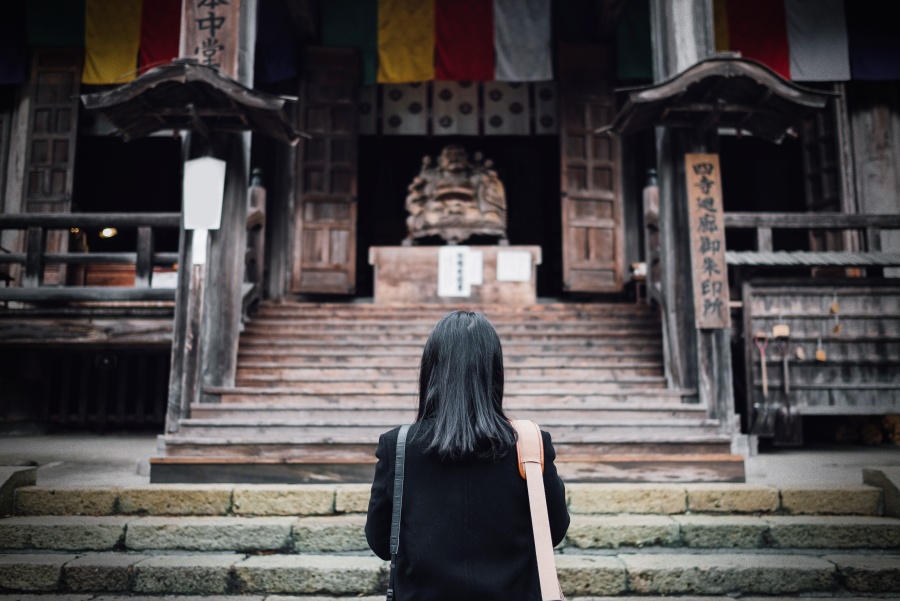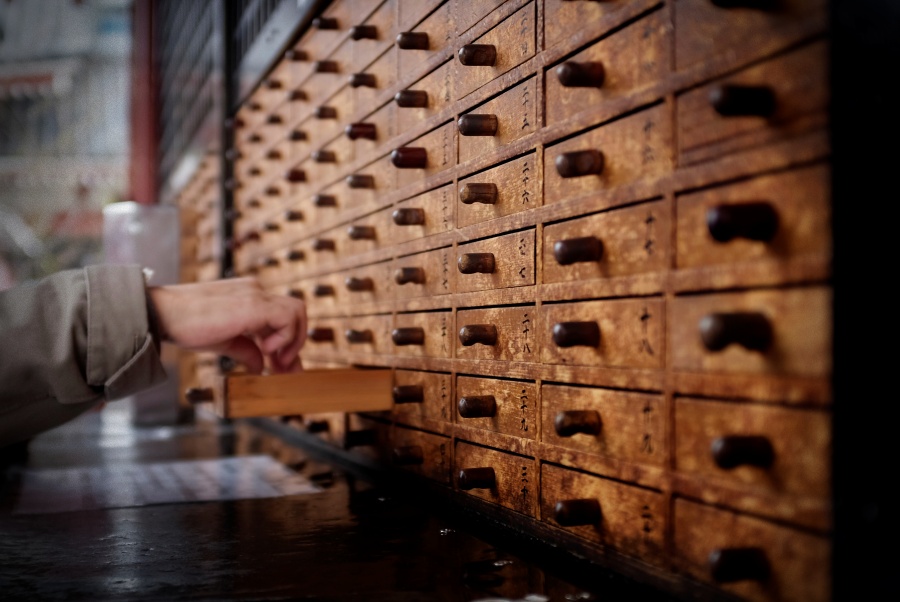Though the Japanese are not mostly known for being religious, did you know that there are over 70,000 shrines and temples in existence in this archipelagic nation? Quite surprising, right? So why are there so many of these establishments out there? What exactly are they for? Let’s find out by reading the following sections.
In this guide, we will share an overview about these temples, what you should do when you visit one, and what are the most popular ones to visit. If this sounds interesting to you, be sure to read until the end of this guide.
Contents
- Best Temples and Shrines in Japan
- Shrines and Temples To See When in Japan
- Atsuta Shrine
- Fushimi Inari Shrine
- Heian Shrine
- Horyuji Temple
- Isasumi Shrine
- Ise Jingu Shrine
- Itsukushima Shrine
- Izumo Taisha Shrine
- Kamakura Hasedera Temple
- Kanda Shrine
- Kinkaku-ji
- Kiyomizu Temple
- Kotohira-gu Shrine
- Kotoku-in Temple
- Kumano Nachi Taisha
- Meiji Jingu
- Motonosumi-Inari Shrine
- Nezu Shrine
- Nogi Shrine
- Sensoji Temple
- Shitennoji Temple
- Taikodani Inari Shrine
- Todaiji Temple
- Toshogu Temple
- Tsurugaoka Hachimangu
- Usa Shrine
- Yasukuni Shrine
- Yushima Seido Temple
- Zojoji Temple
- Shrine And Temple Etiquette in Japan
- FINAL THOUGHTS
Best Temples and Shrines in Japan
Regardless of the reason that you decide to visit, a shinto shrine is likely to be on your list. It’s a chance to see a different kind of shrine, and it’s also a chance to see beautiful places.
Shrines in Japan tend to receive less attention than their counterparts in the West. This is, in part, due to the country’s cultural differences.
A shrine is defined by its name, which usually includes a suffix to its designation, such as jinja (神社), yashiro (社), jingu (神宮),— gu (宮), myojin (明神), sha (社 again), mori (守) or taisha (大社).
If you can’t find a sign with the name of the shrine, keep an eye out for its arch at the front. It will tell you if the building is a shrine or not.
Shinto is animistic faith that believes that there are kami or gods in every part of the world. Not all of them have names, though.
In the context of a shrine, it is usually dedicated to a particular kami. Usually, this person is housed in a goshintai, a physical host.
During festivals, a goshitai is placed in a small portable shrine, which is usually carried by a team of volunteers.
This concept leads to the unusual structure of some shrines, with the larger ones having an upper and lower shrine, while the lower ones do not have a structure at all.
Before that, Shinto collected around a few gods. They also treated large trees and boulders as goshintai in one.
It’s easy to understand why so many people go to these shrines: They feel like they can fall back on their senses when they see nature.
Prior to the establishment of the state religion, there was a definite preference for going to whichever religion suits them.
This belief holds true for shrines, as they see their biggest spikes in visitors during the new year and coming-of-age days. They organize their festivals and other personal visits to make them less frequent, and this prevents them from taking over one’s life.
So when you come across one, remember what visiting temples and shrines in Japan means for the locals and residents:
Passing through holy ground
All shrines have a torii gate. This boundary line separates the holy ground from the secular world.
Bowing once in front of the gate is the proper way to enter. It is also common to walk through the gate without going directly into its center.
Cleansing or purifying your mouth and hands
Take a seat at the temizuya water pavilion and purify yourself before approaching the deity. Once inside, take a scoop of water and perform a cleansing ritual on your hands and mouth.
- For this ritual, scoop up water in a cup with your right hand and pour it over your left hand.
- For the next step, hold the ladle over your right hand and pour the water over it.
- Then, remove the water from the cup and spit it out beside the fountain.
- Pour some water into your left hand and rinse out your mouth. Then, remove the water from the cup and spit it out next to the fountain. Never let the ladle come in contact with your mouth.
Bowing, clapping, and praying
Once you reach the altar, you can throw a coin into the Offering Box.
Ring the bell to greet the deity and to welcome the new moon.
Bow two times.
Clap your hands twice to express joy and respect towards the deity.
Say a prayer while your hands are clasped together.
Bow one last time after.
Japanese Temples
Temples are not as strict as other religious places. However, they do require a certain level of calm and reverence.
An incense bundle is commonly purchased at a temple. Before lighting the incense, place it in the burner and join in silent prayer.
It’s believed that smoke from the incense can heal the wounds and other physical ailments of people. As a result, many people visit temples and sing songs to attract the fire and smoke.
You may be required to remove your shoes when entering temples. Take them with you in plastic bags or leave them on the shelves. Also, be careful not to take photos inside the temples.
Shrines and Temples To See When in Japan
Japan is an Asian country that is also a well-known tourist destination. With its numerous attractions, it is considered the most unique tourist destination in the world.
Aside from its natural beauty, Japan also has a variety of religious attractions, such as Shinto shrines and Buddhist temples. This country is home to some of the most notable temples and shrines in the world.
Atsuta Shrine
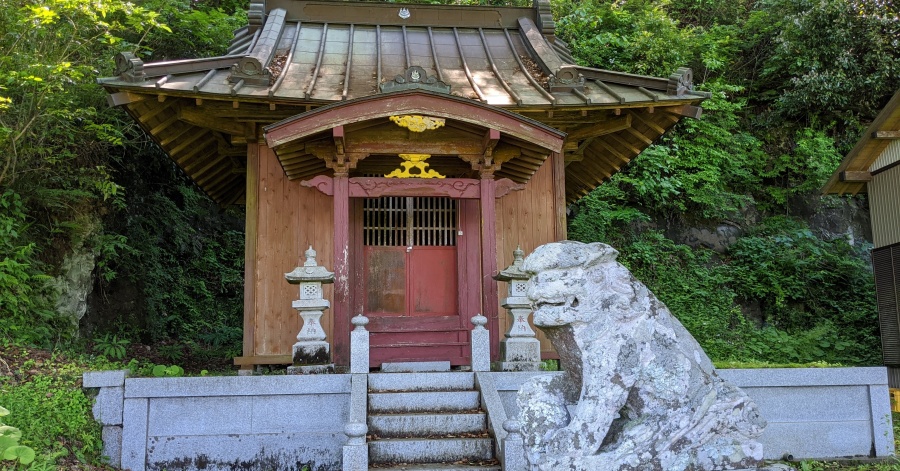
The shrine is dedicated to the sun goddess Amaterasu-Oomikami. This statue, as well as the other sacred items in the building, are never open to the public.
The Five Great Gods of Atsuta are also buried here. Various prayer and worship halls, as well as various other facilities, are also present in this complex.
The Atsuta Shrine is a Shinto shrine that houses the Sun Amaterasu’s sacred sword, Kusanagi. This weapon is not displayed to the public.
Atsuta Shrine is located in a wooded park in Nagoya. It was originally constructed during the Meiji Period.
One of the most pleasant things to do after seeing the shrine buildings in Nagoya is to try the local specialties known as kishimen noodles.
Here’s what Amaryllis thought about their trip to this place: “A shrine on a hill near the railroad crossing (mobile vehicle shooting spot) between Nishihata Station and Fusamoto Station on the Isumi Railway
The company, which may have been protected by the local parishioners, is small but quaint, with a nice view and a quiet rural landscape.”
Address: 〒298-0234 Chiba, Isumi District, Otaki, Oshinuma, 46
Website: https://www.atsutajingu.or.jp/en/intro/
Opening Times: 24 hours (daily)
Price: Free
Google Map Location:
Fushimi Inari Shrine
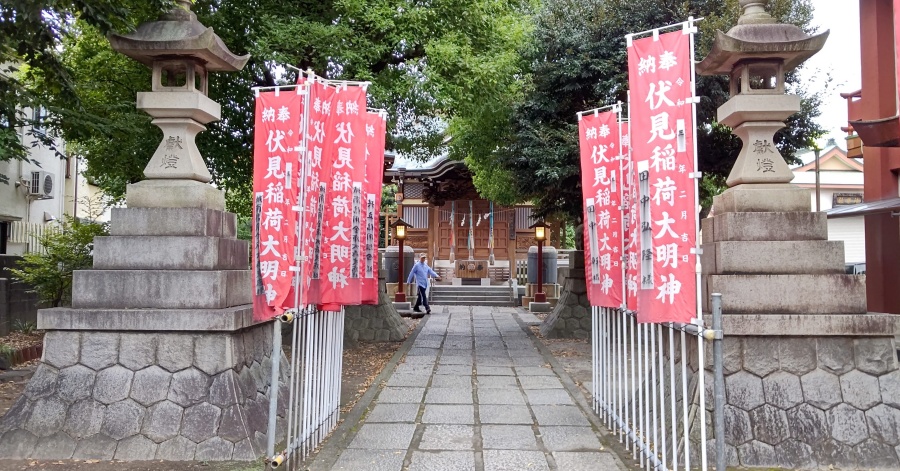
One of Kyoto’s most notable Shinto shrines, Fushimi Inari is located on the mountain paths leading to it. There are around 10,000 torii gates at this site.
This region features numerous torii gates and various other attractions. Aside from these, visitors can also enjoy the festivals and rituals that take place at the various shrines.
Here’s what Phương Thảo Trần thought about their trip to this place: “Where they film The memoirs of a geisha. Super super pretty.”
Address: 2 Chome-24-8 Omorinishi, 大田区 Ota City, Tokyo 143-0015
Website: http://inari.jp/en/
Opening Times: 24 hours (daily)
Price: Free
Google Map Location:
Heian Shrine

In Kyoto, there are numerous temples and shrines. One of these is the Heian Shrine, which was built in 1895. It’s dedicated to the spirits of the emperors who reigned from here.
The Heian Shrine is a must-see for visitors wanting to see the beautiful garden and the imposing torii gate. It’s also a great place to spend a cheap price.
Here’s what Tim thought about their trip to this place: “Very large shrine. Main part is nothing spectacular and gets busy. The garden is beautiful but I recommend only going during seasons when the trees are in full bloom.”
Another guest, Do Hyung Shin, shared their experience visiting this place: “The garden is much more than advertised. Anyone who loves Japanese gardens would be overjoyed to spend an afternoon here.”
Josh Diddams had nothing but high praises about this location during their last visit, saying: “Beautiful shrine complex with a lot of open space and well-kept buildings. No crowds when we visited which allowed the kids to explore the grounds while the adults admired the buildings. Be sure to check out the four statues representing the four cardinal directions (blue dragon – East; white tiger – West; black turtle – North; and I can’t remember – South).”
Address: Okazaki Nishitennocho, Sakyo Ward, Kyoto, 606-8341
Website: http://www.heianjingu.or.jp/
Opening Times: 6am – 5pm (daily)
Price: Free
Google Map Location:
Horyuji Temple
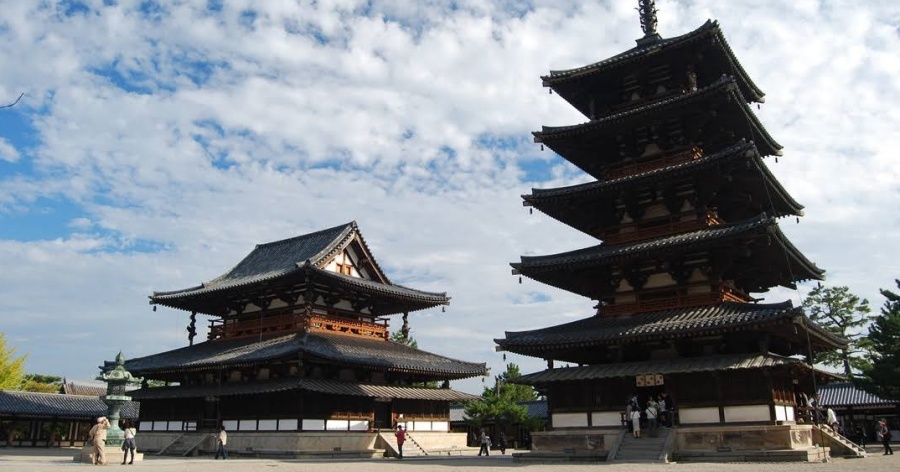
The Horyuji Temple in Japan is believed to be the world’s oldest surviving wooden structure. It features a number of statues of the Buddha.
The Temple has a variety of cultural artifacts and artworks. Aside from these, visitors can also see the Hall of Visions, which has an octagonal structure.
The Hryji Temple grounds are filled with the remnants of Japan’s ancient structures, which can be seen in the photos taken during the Asuka Period.
The story of the Hryji Temple can be traced back to its founding. The legend of this ancient structure can be found in the inscriptions on the back of the Yakushi Nyorai Buddha statue.
Written accounts indicate that Emperor Ymei vowed to build a temple and a statue of Buddha when he was sick.
These details were confirmed by Empress Suiko and Crown Prince Shtoku when they built the temples.
The statue was originally built as a healer for the Yakushi Nyorai. It was then named after the place where it was located.
Here’s what Dennie Lim thought about their trip to this place: “The access is quite easy by bus, but if you have time, you can walk(20min) and can see pokemon sign like in photos. The entry ticket are 1500. Didnt go inside, maybe next time.”
Another guest, Patrik Pindeš, has this to say about their last visit to this place: “It’s the oldest preserved wooden temple complex in the world, definitely worth to see. The two pagodas are the main attraction, but the gate with the 2 guardians is nice and all the surrounding area with all the other historical buildings, park and museum (exhibits dating back to the 6th century, mostly statues) are beautiful. I suggest you to follow the tour guide inside the brochure that you get with the ticket, It makes you explore all the interests systematically, so you do not miss anything. I would reserve at least 3 hours (including a 1 hour visit inside the museum) to explore and appreciate the soul of this place. It’s about 30 minutes walk from the train station.”
Meanwhile, ADream In Japan shares some tips based on their experience visiting here: “Huuuuuuuuuuuuuuuuge. Arrive early for free parking at the visitor center and expect to spend at least 1-1.5 hours here. There’s restaurants nearby. They have a decent English pamphlet inside the paid area which is UNESCO world heritage structures.
To the west is the west round tower on a hill, with the hourly bell. The monk who rings the bell counts by moving rocks over. It’s cool. When he is not ringing the bell, he signs a special goshuin/seal.
Inside the main paid area for ¥1500(combo ticket for 3 areas) is the Goku-no-tou “5 story pagoda”, Kondou “main hall” (with statues in honor of Prince Shotoku dating from 7th century) and Daikoudou “the lecture hall” with more original wood structures. These are the UNESCO worlds oldest wooden structures and Japans oldest 5story pagoda.
Just to the east of the main area is the Shouryoin, “temple of shotoku’s soul where you can get 7 additional (8 total with west tower seal) goshuin. Each seal is ¥300. During covid only the main seal is being done normally. You can sit and pray here.
Behind that temple is the Daihozoin, a galley of treasures included in your combo ticket.
Just east of that gallery is a small area that requires another ticket.
If you continue to the Far East side, down a long stone paved path you reach the last area on the combo ticket, Toin Garson,”the eastern precinct” with an octagonal pavilion “ the hall of visions” the oldest in japan houses a perfectly intact gold guided statue of Prince Shotoku, which is only opened to the public twice a year (4/11-5/18 and 10/22-11/22). Also in this area are quite well preserved painted sliding doors depicting Shotoku’s entire life.
That’s the main highlights! Awesome place filled with history and lots of Japanese junior school history test questions!”
Michael Cappola, another guest, had nothing but high regards for this place: “One of my absolute favorite shrines. Some excellent examples of ancient architecture and it’s far away from Nara so you can escape the crowds. Some of the oldest wooden structures on the planet and one of the shrine that kept its style throughout the years. Don’t miss it.”
Address: 1-1-1 Horyuji Sannai, Ikaruga, Ikoma District, Nara 636-0115
Website: http://horyuji.or.jp/en
Opening Times: 8am – 5:30pm (daily)
Price: 14 USD
Google Map Location:
Isasumi Shrine
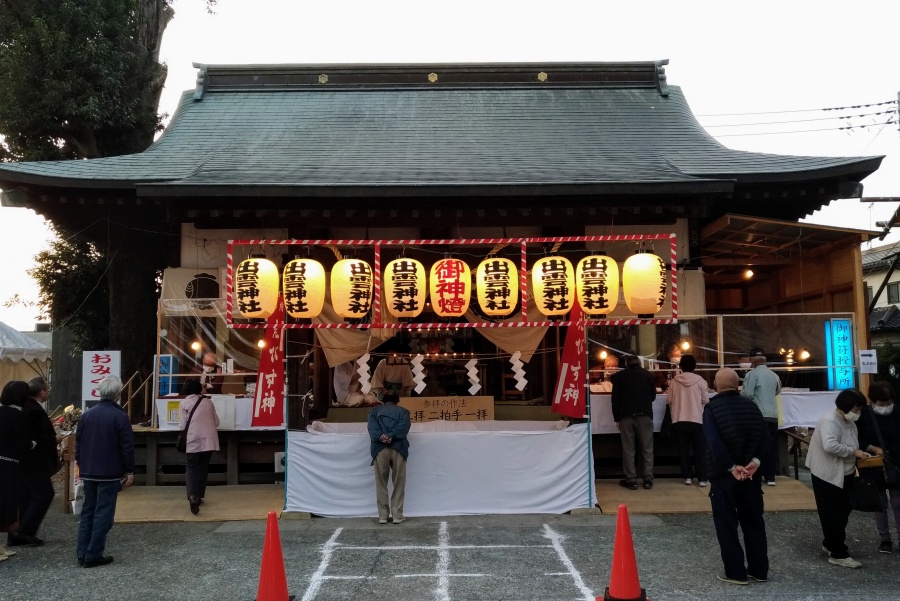
The Isasumi Shrine is located in Fukushima Prefecture, Japan. This Shinto shrine is known for its rice planting ritual.
The main features of the shrine are the statues, torii gate, and the beautiful garden. During the various seasons, the shrine can be visited anytime.
During the festival, which is held every year, various performances and food booths are held. The ruins of the main shrine are also featured.
It is believed that the place name “aizu” was taken from the place where the father and son of four shoguns lived, which is a sacred place in aizu. At this time, two gods, one of which being the god of land development, were worshipped on the niigata prefecture border.
Emperor kinmei was transferred to a land in the area known as Takada Minamihara in 13 years, and then another temple was built in the same period.
Since it was moved, it has been a formality for the koku-ichinomiya to oversee the aizu’s general guardian, who is known as meishin taisha and iwashiro.
It has attracted the most reverence from outside and inside the prefecture. The myth of the four-way shogun states that advanced culture was prevalent in this area.
Here’s what Kazuo Nakamura thought about their trip to this place: “Once a year the festival of 11/19 · 20 (Izumo Shinto shrine) ・ Isasumi Shinto shrine (God of Anno) On this day, treasures, bills and other shops are out and it is fun.”
Another guest, , shared their experience coming here: “There are many worshipers during the Ebisu class in November, but it is a very quiet shrine on normal days. This shrine is a shrine for those who worship the Ebisu lectures in the city.”
Address: 8 Hamachō, Ota, Gunma 373-0853
Website: http://www.aizu-reichi.gr.jp/isasumi/index.html
Opening Times: 24 hours (daily)
Price: Free
Google Map Location:
Ise Jingu Shrine
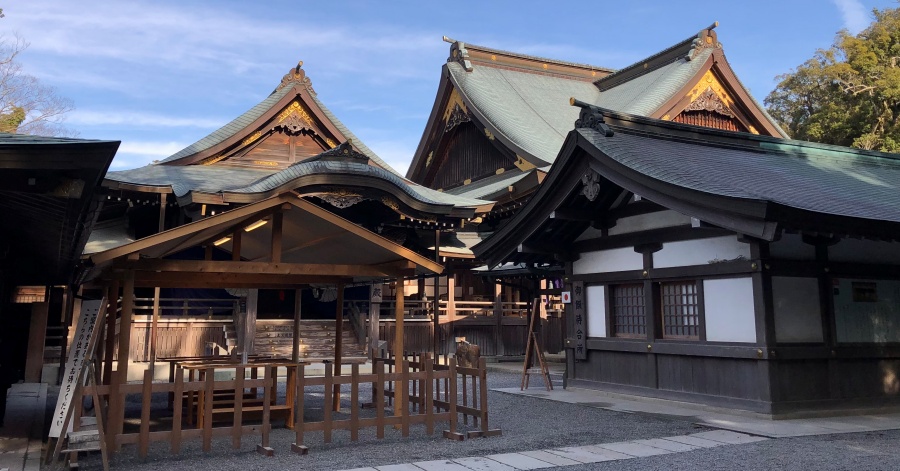
The Ise Jingu Shrine is the place where Japan’s guardian, Amaterasu-Omikami, was buried. There, he was worshipped as a Shinto deity.
The Geku shrine is a must-visit for anyone wanting to pray for Toyo’uke-no-Omikami. This site features ancient structures and carvings, and visitors can offer their prayers.
It was previously believed that Amaterasu-Omikami was worshipped in the Imperial Palace. However, during the reign of Sujin, the Holy Mirror was moved to another location.
During the reign of E
mperor Suinin, Princess Yamatohime-no-mikoto was asked to find the proper place to permanently enshrine Amaterasu-Omikami.
After searching for him for over 2,000 years, the princess learned that he should be worshipped in Ise.
Around 1,500 years ago, Emperor Toyo’uke-no-Omikami was summoned from the north of Kyoto Prefecture and enshrined in Ise.
Here’s what Prabhash Muthumala thought about their trip to this place: “World famous sacred Shrine, located in Ise, Mie prefecture.
Mind relaxing atmosphere. Unique scenery also with Isuzu river. People called it as the soul of japan.
If you visit Japan, try to visit here. Amazing experience if you visit by train ? There is a bus service until 6pm from iseshi station ? Also you can enjoy street foods and the regional culture. Blessed ?.”
Another guest, Yuke S, has this to share about their most recent visit here: “I took my in-laws to the shrine when they visited us from USA. It has a nice atmosphere, and they were holding some ritual event on the day we visited. It was a nice walk, and they were happy about its traditional feeling and chickens walking around.”
Meanwhile, Crystal Phelan, had nothing but high regards about this place, saying: “Spectacular. As an English speaker, if it weren’t for the Japanese friend who explained the significance of this shrine, I wouldn’t have appreciated it nearly as much. When I return my omamori in the future, I intend to do a tour to better learn the Shrine’s significance.”
Address: 1 Ujitachicho, Ise, Mie 516-0023
Website: https://www.isejingu.or.jp/en/
Opening Times: 5am – 6pm (daily)
Price: Free
Google Map Location:
Itsukushima Shrine
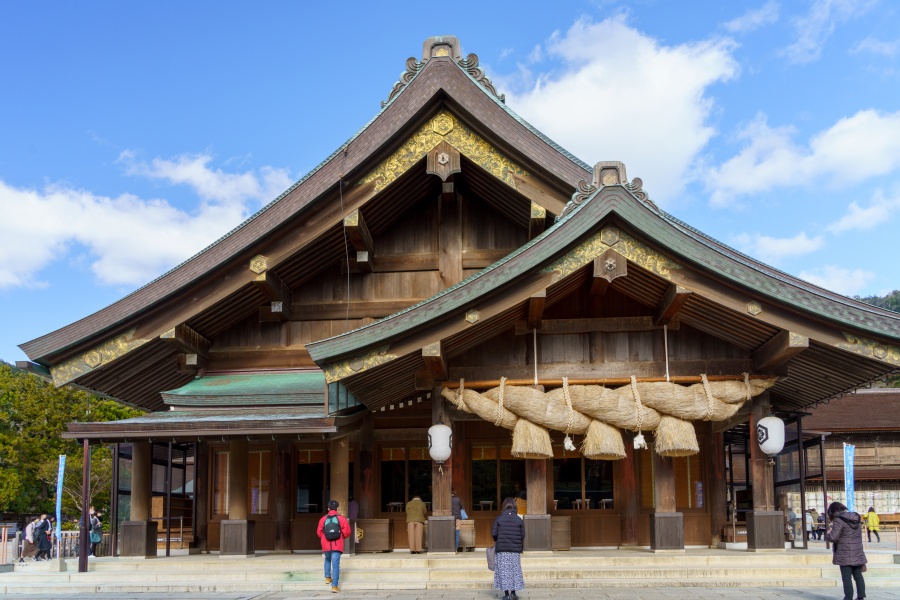
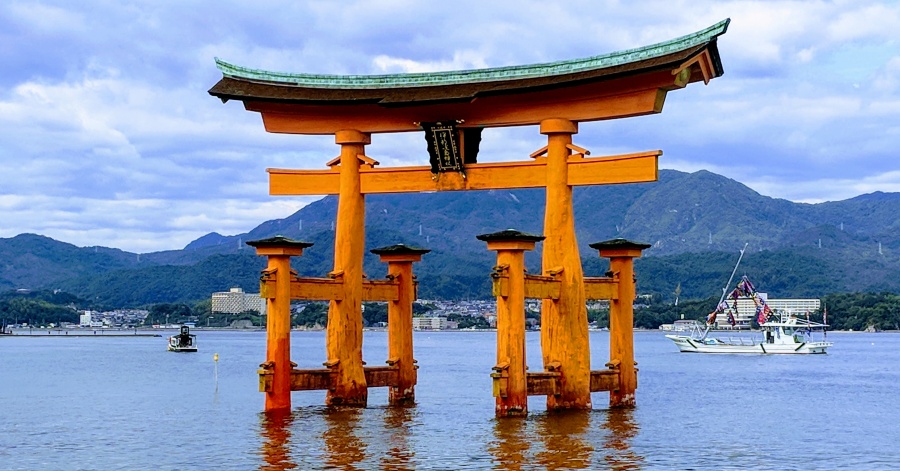
Itsukushima Shrine is a UNESCO World Heritage Site located in Japan. One of the most iconic places in the area is the Otorii gate, which can be found out in the sea near the site.
The Itsukushima Shrine is built on the water. The various buildings on the site include the main hall, prayer rooms, a noh theatre, and various other facilities.
The three deities at Itsukushima Shrine were created when its founder, Amaterasu umikami, and her brother, Susanoo-no-mioto, made a pledge on the celestial plain.
Since ancient times, these deities have been regarded as the keepers of the nation and protect its seafarers.
When the deities looked for a place to settle, Saeki no Kuramoto, who was the island’s ruler, received an oracle. He was led by a divine crow and built a shrine on the island.
The shrine was rebuilt in 1168 by Taira no Kiyomori. It was constructed in a style known as shinden-zukuri.
As Kiyomori ascended the imperial court, other prominent individuals visited the shrine, such as former Emperor Takakura and his wife, Kiyoirakawa.
After the Taira era, the shrine was revered and visited by various ruling Genji clans. It was also patronized by Ashikaga Yoshimitsu and other shoguns during the Muromachi period.
In 1996, the Itsukushima Shrine was declared a UNESCO World Heritage Site. It joins the likes of Matsushima and Amanohashidate.
Here’s what Kingston Obike thought about their trip to this place: “On an island that’s renowned for it’s grand Tori gate that gets partially submerged depending on the tide, unfortunately, it is still under construction. However, there’s still lots to see in the shrine if you’re a history enthusiast, have an interest in the construction methods of old, or just love the feel of being all close and personal with nature on an island. The view of the surrounding waters is truly a sight to behold.”
Another guest, Elias Chelala, has this to say about their last trip here: “Beautiful Shrine with several areas including the Main Shrine, a five-storied Pagoda and Ōtorii gate. Unfortunately the famous Torii gate in the water is under construction but I still enjoyed my visit. Make sure you try the delicious oysters in the nearby markets and pet the friendly deer.”
Meanwhile, Matilda’s Mom has this to share about their most recent trip to this site: “Good day trip recommended from Hiroshima. Travelled by train to Miyajima and jumped on a ferry to the island of Itsukushima. All fares were covered by our JR West Kansai Hiroshima Pass. Lots of places to explore on the island including this popular shrine, plenty of shops and food places to discover.
We made it a point to try the oysters as it’s popular in the area. The friendly deers roaming around freely were quite adorable. Unfortunately, the torii gate was being renovated during our visit (November 2019). Make sure to allow several hours to spend on the island. And since we travelled pre-Covid19, we spent a bit of time lining up to board the ferry back to the mainland because of the huge number of visitors. Lines moved quickly though.”
Address: 1-1 Miyajimacho, Hatsukaichi, Hiroshima 739-0588
Website: http://www.en.itsukushimajinja.jp/
Opening Times: 6:30am – 5pm (daily)
Price: 3 USD onwards
Google Map Location:
Izumo Taisha Shrine

Izumo Taisha is a shrine located in Izumo in Japan’s Shimane Prefecture. It is one of the country’s most important shrines.
There are no records of when the Izumo Taisha was built, but it is widely believed that it was around the 700s.
Prior to the creation of Japan, Izumo was ruled by a powerful clan. The main deity in this area is Okami.
According to creation myths, Okami was the ruler of Izumo. He was also known for having good relationships.
Visitors are required to clap their hands multiple times instead of just two.
Since the exact date of its construction is unknown, it is regarded as one of the oldest Shinto shrines in Japan.
It is believed that many of the Shinto gods gather at this shrine once a year to receive their blessings.
The main shrine has a massive building with various torii gates and other features. There are also various smaller shrines located in the area.
Here’s what Nguyen hung thanh thought about their trip to this place: “I got chance to visit Izumotaisha, one of the most famous jinja in Japan, the place Japanese want to visit before died. Japanese think that this place is the jinja of jinja, where gods of Japanese in everywhere come to here, make festival, meeting and connect love. In fact, this is the biggest jinja I have gone in Japan.”
Another guest, Noriaki Okada, has this to sharer about their experience visiting here: “The very first biggest shrine build about 2600 ago. double or 4th time bigger than recent one. You can check them evidence found in front of the center of shrine as the big pillars and photo.
This shrines god are famous for good relationship not only love but work or any relations. and kind a headquarters of all shrines in Japan. Good luck.”
Daisuke Tomita, a very satisfied guest, shares this about their travel experience: “One of the most famous shrines in Japan. I’ve always wanted to visit here.
It takes 30 minutes from Izumoshi station by bus.
The way of worship is unique, for it’s 2 vows, 4 claps, and 1 vow, though in most shrines it’s just 2 claps not 4.
Shimenawa is also great.
Around the grand shrine, there are some soba restaurants. It is really tasty.”
Address: 195 Taishacho Kizukihigashi, Izumo, Shimane 699-0701, Japan
Website: http://www.izumooyashiro.or.jp/
Opening Times: 24 hours (daily)
Price: Free
Google Map Location:
Kamakura Hasedera Temple
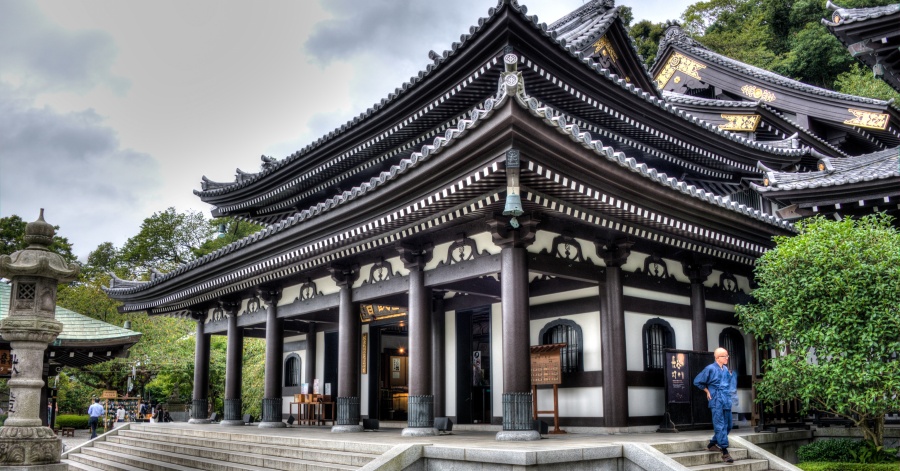
Hasedera is a temple located in Japan. It is known for its massive wooden statue of the goddess of mercy, Kannon.
This statue, which is believed to be the tallest tree-shaped statue in Japan, was reportedly carved from the same tree as the Hasedera Temple’s statue.
The Hasedera temple complex is built on a hill that’s surrounded by woods. The buildings on its slope have terraces.
There are also various restaurants and shops selling Japanese food and drinks.
The entrance to the complex is located on the hill’s base. The gardens on the other side have ponds.
The garden of the temple is named after Benten, a goddess of wealth and beauty. There are also statues of other gods in the cave next to the hall.
The Kannon Museum is a small museum that’s located inside the main hall. It displays various relics from the temple.
On the other side of the main hall is the Amida-do Hall, which has a three-meter tall golden statue of Amida Buddha.
Here’s what Jesus ZQ. (BFL) thought about their trip to this place: “Kamakura is one of those places you can’t simply do in a single day… well, maybe… but you won’t appreciate all the amazing things at each spot. This temple is a clear sample of that and is a must to visit.
Easy to walk and family friendly. There are stairs, keep that in mind for strollers.
Parking lot right at location. Other nearby parking lots also available.
Not too far from this temple (a few meters away) is the big Buddha. I would suggest to do that one after this temple… why? There are lots of food options near that area.
Beach is also not far away, so enjoy some history and then go relax by the ocean. If you go there, check out good mellows burger. You won’t regret it.”
Another guest, Fox God, has this to share about their last visit here: “One of the most beautiful places in Kamakura. The gardens, temple buildings, and even a cave with statues carved into the walls, all magnificent. The 400 yen admission is well worth it.”
Christian Ardito, a very satisfied visitor, has this to share about their trip here: “Amazing – Must See Temple! The Hasedera Temple in Kamakura was definitely one of the highlights of my trip to Japan. Lots of structures and shrines to visit and an amazing view of Kamakura, which is by the Ocean. One of my favorite discoveries in Hasedera Temple was a small cavern where people place small statues of Buddha to make a wish. Plan to spend a couple of hours (at least) to really enjoy it.”
Address: 3 Chome-11-2 Hase, Kamakura, Kanagawa 248-0016, Japan
Website: https://www.hasedera.jp/
Opening Times: 8 am – 5 pm (daily)
Price: 3.64 USD
Google Map Location:
Kanda Shrine
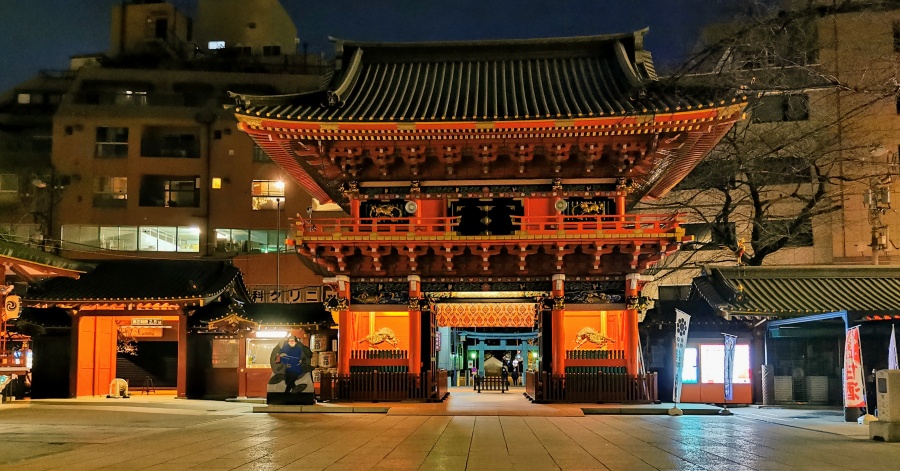
The Kanda Shrine is a place of worship in Tokyo. It is home to one of Japan’s biggest festivals.
This temple is filled with people praying for good luck and success. They also believe that these deities will be enshrined.
The annual festival known as the Kanda Matsuri is held in March and involves various processions and displays through Tokyo.
One of Tokyo’s most important shrines, the Kanda Myojin is also host of one of the country’s three major festivals.
The Kanda Myojin Shrine was established in around 1300. It is one of Tokyo’s oldest temples and is known for its numerous attractions. Most people visit it to pray for good luck and marriage.
Due to its proximity to Akihabara, it has become popular with tech geeks. The temple also sells talismans to prevent harm from falling from electronic devices.
The main gate at the Kanda Myojin is truly beautiful. Inside, there are numerous elaborate carvings and colorfully-painted motifs.
The Kanda Myojin Shrine is also the host of one of Japan’s three major festivals. This event, which is held on the 15th of May, involves a massive parade.
The entire temple is open all year round, and admission is free.
Here’s what Lumanti Maharjan Chitrakar (Lumu) thought about their trip to this place: “Best time to visit Japanese shrines is in the evening. The shrine glowing with lights and positive vibes. There were scripts in each monuments, it would be helpful for foreigners like us to know about the place if they were translated in English too.”
Another guest, Justin Kaneshiro, has this to share about their last trip here: “Very nice Shinto Shrine. One of the oldest in Tokyo. Famous for being one of the featured locations in Love Live.
They do a lot of collaboration events with other anime series too and sell limited exclusive merchandise for the collaborations which are totally awesome.
Because of the massive amounts of foreign visitors coming to this shrine every year the shrine staff can speak English to a certain degree.
Highly recommend visiting to get a feel of traditional Japanese culture in the middle of a ultra modern city.”
Meanwhile, Takamitsu Yamakawa, a very satisfied visitor, has nothing but praises for their experience in this location: “Kanda Myoujin is the one of famous shrine in Tokyo. There are not only traditional culture but also pop culture in this shrine. Sometime he has new culture and traditional culture collaboration events. Nearby here there are some good restaurants. So you can enjoy Japanese culture and good foods.”
Address: 2 Chome-16-2 Sotokanda, Chiyoda City, Tokyo 101-0021, Japan
Website: http://www.kandamyoujin.or.jp/
Opening Times: 24 hours (daily)
Price: Free
Google Map Location:
Kinkaku-ji
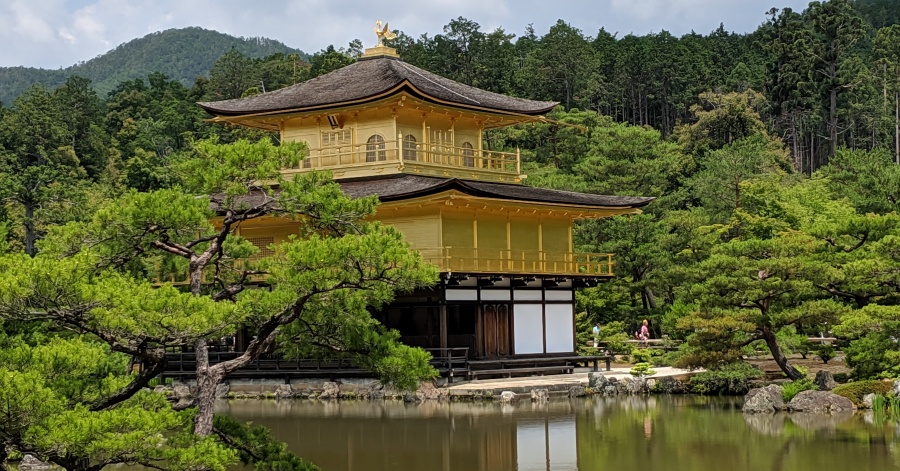
Kinkaku-ji is a well-known temple in Kyoto. It has been named a UNESCO World Heritage Site.The temple grounds are filled with Buddhist relics and the teachings of Buddha. The main Zen temple is located on the site.
This temple features various natural and man-made features. The image of the deity is reflected in the water of the mirror pond.
The Kinkaku-ji Temple is commonly viewed from the adjoining pond. It features a magnificent view of the city of Kyoto.
The building originally housed Ashikaga Yoshimitsu’s residence. It was then converted into a Zen temple after the former Shogun died.
In 1950, a young monk burned down the Kinkaku-ji Temple. Despite the incident, the structure was rebuilt in 1955.
Here’s what Arifa Jannat thought about their trip to this place: “One of the most famous spots in Kyoto, temple of the Golden pavilion. Actually, it’s a Buddhist temple which is covered with golden leaf giving an iconic mirror view. Usually, the area is crowded and I recommend you to go there early morning. You can enjoy a relaxing walk through the wayside. The entrance fee is 400 yen.For road direction, both English and Japanese language are indicated. Highly recommended this place for people who like traditional and historical view.”
Another guest, Kieron Johnson, has this to share about their experience visiting here: “Kinkaku-ji has never been among my favourite Kyoto temples, but at 3:00 pm in the winter sun under an azure sky it is utterly irresistible.
I cycled here from Ginkaku-ji on the other side of the city, which IS among my favourite places in Kyoto but today I think it was honours even.”
Meanwhile, a very satisfied guest, Andres Botero, has nothing but praises about their most recent experience visiting here: “This is a really special place. Even though is very touristic and sometimes there’s too many people, it manages to remain special and to convey calm and peace.
Beautiful surroundings, stunning temple. You can’t get very close to it, but it is easy to take a round and see it from all angles.
Take your camera with you and spend time taking pictures after observing very well the scenery. There are many details and nuances that are wonderful to discover. It’s worth a visit, don’t rush it. Enjoy it.”
Address: 1 Kinkakujicho, Kita Ward, Kyoto, 603-8361, Japan
Website: https://www.shokoku-ji.jp/en/kinkakuji/
Opening Times: 9 am – 5 pm (daily)
Price: 4 USD
Google Map Location:
Kiyomizu Temple
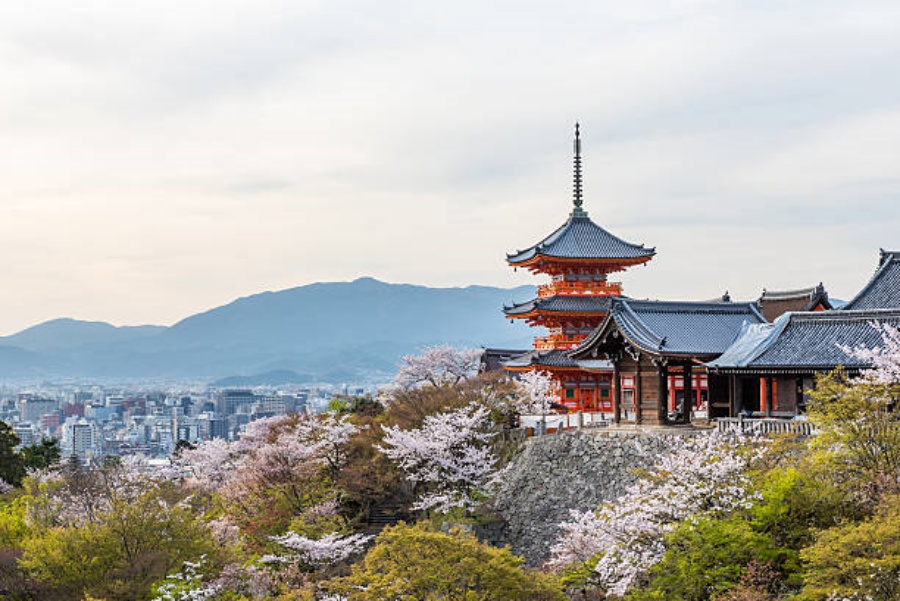
Kiyomizudera is a shrine located in Otowa Falls in Japan. It was established in 780 and derives its name from the purity of the water.
The Kita Hosso sect originally established this temple as a school within Japanese Buddhism. It was then incorporated as a separate entity in 1965.
Kiyomizudera is known for its wooden stage, which can be found on the hill above its main hall. This feature allows visitors to see the various cherry and maple trees that grow in the area.
The main hall of the temple is equipped with a stage and a small statue of the Tenfaced Kannon.
Behind the main hall is the Jishu Shrine, which is a place where the deity of love and matchmaking can be found.
It is believed that by finding your way from one stone to the other, luck will be brought to you.
Otowa Falls is located in the center of Kiyomizudera’s main hall. It has three streams and is known to attract visitors.
According to folktales, the water from a stream can cause longevity, good luck, and a flourishing love life.
The other structures on the site include the Okunoin Hall, which looks pretty similar to the main hall. Near this area is a room dedicated to the Amida Buddha and Shaka Buddha.
The Koyasu Pagoda is located on the other side of the temple grounds, and it is believed to provide an easy and safe childbirth.
Outside of the paid area, there are various other structures that can be found within the Kiyomizudera. These include the vermilion pagoda, the Zuigudo Hall, and a room dedicated to Buddha’s mother.
Getting to Kiyomizudera is a lot of fun as it happens since the road to the temple is steep and busy in the nearby Higashiyama District.
The area has a variety of shops and restaurants that cater to both pilgrims and tourists. Some of these include Kiyomizu-yaki restaurants and sweets shops.
The Higashiyama district and other temples in the area have special illuminations that are held during different occasions.
The highlight of Kiyomizudera is its beautiful architecture, which is evidenced by the statues of the Tenfaced Kannon and the Tenfaced Kako.
Visitors can also visit the other areas of the temple by drinking the Otowa Falls’ pure waters.
Here’s what n ! d z thought about their trip to this place: “Beautiful during autumn. You can enjoy the scenic view at the top. Entrance fee is ¥800 for adults. It was crowded during weekend and despite the rainy weather. You can explore the bottom area of the temple for free. The entrance fee is applicable if you want to go to the very top.”
Another visitor who goes by the name Omoroi Life shared their experience visiting here: “One of the most famous temples in Kyoto, this structure is a delight to enjoy with great views, but still with relatively easy access. But due to this fact, is extremely crowded during tourist seasons. Architecturally this temple is very interesting, as it was built extending off the mountain peak. The street leading up to the temple is filled with lots of great shops, with a variety of goods.”
Meanwhile, here’s what Jiwon Lee can share about their travel experience to this spot: “Beautiful temple with even better sunset view. After sun sets, lights are turned on to make it even more photogenic. The walk up and down the temple was a good exercise and the views paid off. But there were too many people packed in layers to take photos.”
Address: 1 Chome-294 Kiyomizu, Higashiyama Ward, Kyoto, 605-0862, Japan
Website: https://www.kiyomizudera.or.jp/en/
Opening Times: 6 am – 6 pm (daily)
Price: 7 USD
Google Map Location:
Kotohira-gu Shrine

Kompirasan is the main shrine of Japanese sailors and their families. It is located in various areas in Japan.
The place where it’s located is in Kotohira, Japan. The trek to the temple consists of over a thousand stone steps.
It was previously regarded as a mixture between a Buddhist temple and a Shinto shrine. It was officially declared a shrine during the Meiji Period.
Although the former has mostly been depicted in the shrine’s architecture, the symbiosis between the two has still remained intact.
During the Edo Era, commoners were allowed to go on pilgrimages to certain places, though they had to bring their own pets along with them.
There is a statue of a Konpira Inu at the 431st step. At the Haraedo-sha Shrine, a god known as Haraedo-sha is worshipped. The Asahi Shrine is also a sight to see.
There is a shrine located at Step 642 of the Sakakimon Gate, and it has various trinkets that are made from silk thread and are known to bring good luck and happiness.
Despite its more challenging approach, Kompirasan is still very popular among pilgrims from all around Japan.
The path begins in a shopping arcade that’s filled with Sanuki Udon restaurants and souvenir shops. It goes past several shrine buildings.
The shopping arcade’s various attractions help visitors reach the shrine’s main hall, which is located inside the building.
One of the areas that visitors can visit is the Ema Hall, which features displays photos of the various vessels that have been stationed at the temple.
Most of the time, the pilgrims only visit the main hall. However, there are also over 570 steps up to the shrine’s inner shrine known as Okasu.
The main shrine of Kompirasan is located in Japan’s Kotohira district. It is known for its numerous temples dedicated to the seagoing sailors.
It used to be regarded as a mixture of a Shinto and Buddhist temple. However, since the beginning of the Meiji Period, the two religions were separated, and the former was declared a shrine.
The Toranomon Kotohiragu is a Shinto shrine located in Tokyo. It is nestled in the middle of Tokyo’s busy streets and provides a peaceful haven from the city’s hubbub.
This 400-year-old establishment features a variety of statues, paintings, and carvings. It also holds folk dances performed by the devotees.
Here’s what Armando Landin thought about their trip to this place: “The day we decided to climb the hundreds of steps to this shrine just happened to be one of the hottest and sunniest days of the summer. But it was still worth it considering the beautiful scenery along the way. We loved the main shrine most of all. It’s is gorgeous and surprisingly wide. Those who make the climb should grab bottles of water in the lower area where the shops are located; it becomes difficult to find anything to drink once you are in the more natural setting. Also, there is a spot in the middle where birds will land on your hand if you stick your arm out with your palm facing upward. They are looking for food, so take some sunflower seeds with you! And many folks bring a cane or walking stick to help with the climb up the stairs. Our nearby hotel loaned canes to us, but they can also be found for sale in some of the shops at the base of the hill. Overall, expect a tiring but fulfilling experience.”
Another guest, ZDR, shared their thoughts about their last visit here: “This shrine is a good place to go hiking and shopping. There is a lot of beautiful nature. Also, near the top you can get a great view of the city. I recommend getting drunk before hiking. Being drunk is fun. Hiking while drunk is even more fun. The only issue is that you may have some difficulty recalling the hike if you’re too drunk. That’s okay. Your photos will remind you.”
Meanwhile, aa very satisfied visitor, Rahul Kurup, shared their fond memories and even some tips on how other guests can best enjoy this spot, saying: “Tip: There is foot onsen in the street that is free for people visiting shrine. Open from 9 to 4 pm. There is onsen too close to that. But skipped it as we had an onsen in the hotel.
Almost 1368 steps and takes around 2 hours to reach the top shrine. A really good hike that takes a bit of an effort. Lot of shops and eateries on both sides. Nice shrines. Very peaceful and green with nice views. Try to go all the way up or you can do till middle shrine (~785steps).”
Address: 892-1, Kotohira, Nakatado District, Kagawa 766-8501, Japan
Website: http://www.kotohira.or.jp/
Opening Times: Mon – Fri: 9am – 5:30pm; Sat – Sun: 9am – 4pm
Price: Free
Google Map Location:
Kotoku-in Temple
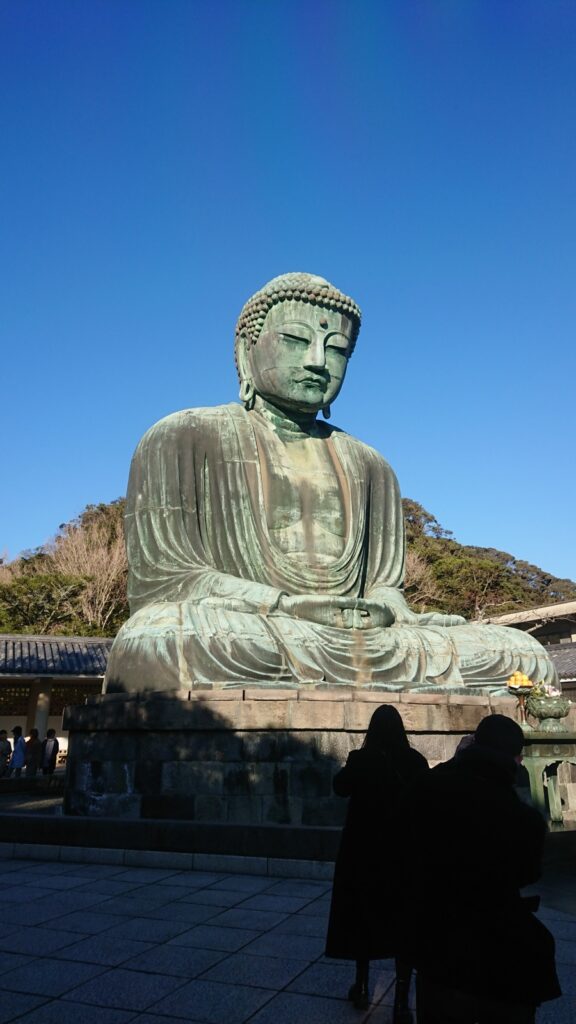
The image of the Buddha is regarded as one of the largest statues in Japan. It is also the main worship image at the temple.
This magnificent copper statue, which is known as Kamakura Daibutsu, is located in the center of Kamakura city.
The origin of the Great Buddha can be traced back to a rivalry between rival monks.
Four years after his death, the Buddha’s wish to build a similar monument in his own town was denied by his court. Through the efforts of his wife, Inada, the project was made reality. (The rivalry between the Zen sect and the Jodo sect led to the establishment of the Kotokuin Temple.)
The original Buddha was a wooden structure that was destroyed by a storm. Its replacement, which is a bronze statue, was made in 1252.
The Great Buddha’s hall was originally constructed as a large hall. It was then destroyed by a storm in 1369 and washed away by a tidal wave in 1495.
The statue underwent various renovations after it was damaged by an earthquake in 1923. It was also strengthened with shock absorbers in 1960.
Due to the angle at which the statue is placed, the proportions of its body are distorted to make it look more realistic.
Here’s what Moubachir Silicon Valley thought about their trip to this place: “Amazing site. It is huge , Great place to visit. Kamakura is a seaside Japanese city just south of Tokyo. The political center of medieval Japan, modern-day Kamakura is a prominent resort town with dozens of Buddhist Zen temples and Shinto shrines. Its most recognizable landmark is the Kotoku-in Temple’s Great Buddha, a roughly 13m-high bronze statue still standing after a 15th-century tsunami. Yuigahama Beach on Sagami Bay is a popular surfing spot.”
Another guest, Samuel Piatscheck, has this to share about their last visit: “Awesome to see, the Buddha is way bigger then you expect and can’t be pictured well. Atleast not by me. If you are around the area. It’s a really highly recommended place to go and see.”
Meanwhile, a very satisfied guest, Ridho Affandi, has nothing but praises about the location: “A temple complex famous for having giant Buddha statue. You need to pay around 300 yen to enter, but the explorable area is vast and clean to the point of worth to visit. The toilet is clean and you can get some area-limited merchandise in the souvenirs shop. The side garden is also a great place to catch some breath.”
Address: 4 Chome-2-28 Hase, Kamakura, Kanagawa 248-0016, Japan
Website: https://www.kotoku-in.jp/en/
Opening Times: 8 am – 5pm (daily)
Price: 3 USD
Google Map Location:
Kumano Nachi Taisha
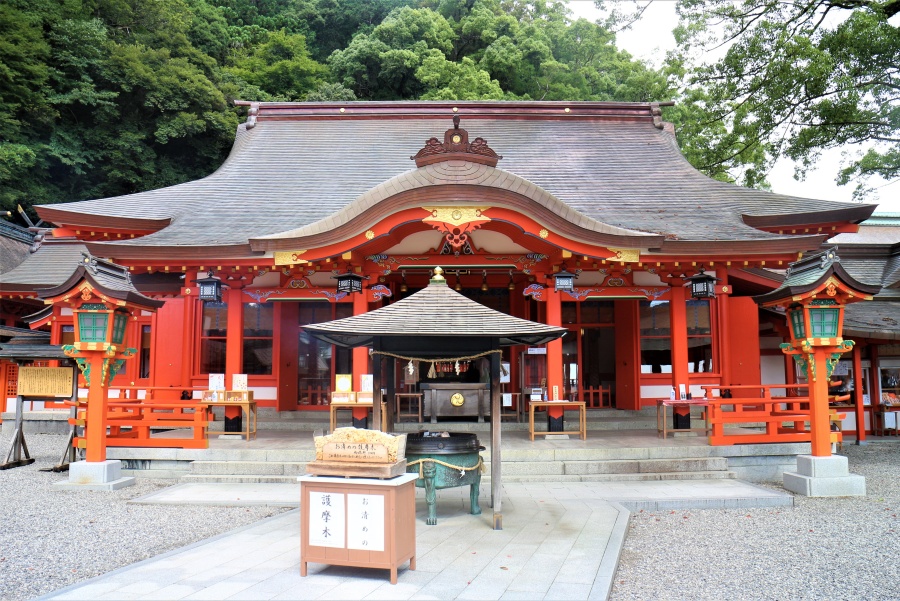
Located in the Nachi mountain region, this shrine is a part of the pilgrimage site known as Kumano Sanzan.
This is the site of Japan’s tallest waterfall, which measures over 133 meters tall. The awe-inspiring natural features of this area also contribute to its mysterious aura.
The shrine has a cobblestone path that leads to its main gate. The trees lining its path also contribute to the area’s beauty.
The Nachi Taisha Grand Shrine is one of the three temples within the Sanzen region.
The Nachi Taisha Shrine and the Seigantoji Temple were both established as one institution until they were separated in the Meiji Period.
Before Buddhism was officially established in Japan, the area’s Shinto temples were already being worshipped.
The Nachi Taisha Shrine is only about a kilometer away from the Nachi Falls, which is the highest waterfall in Japan.
The beautiful buildings and grounds of the Nachi Taisha Shrine are surrounded by mountains and the falls.
Here’s what Tee F Kay thought about their trip to this place: “What a wonderful temple place!!!
Absolutely worth every single step uphill, and the travel with local trains from Osaka to be compensated with a unique temple complex of the 3-legged-raven.
Yes, GOT-fans … a raven with 3 legs, not with 3 eyes 🙂
As in most places try to be here early. Even though the shrines and temples open up around 9:00, you will have chances to explore the complex and take some good photos for memories, without the risk of being photo-bombed.”
Another guest, Asitha Liyanage, has this to share about their last visit here: “KUMANO KODO is one of the most beautiful places I’ve ever been to. You will be mesmerized by the beautiful greenery view and it definitely was a healing trip. The hiking trail were little bit tiring but it totally worth trying. I’m going there for a full hike again for sure.”
Dr. Michael Kohlberger, BSc MSc, a very satisfied guest has nothing but praises to share about this site: “Beautiful shrine area. Walking up here was worth every step. There are some benches to sit and the view is excellent. The temple itself is in great condition and there are some shops around. An incense burner completes the mystical atmosphere.”
Address: 1 Nachisan, Nachikatsuura, Higashimuro District, Wakayama 649-5301, Japan
Website: http://kumanonachitaisha.or.jp/
Opening Times: 9 am – 6 pm (daily)
Price: Free
Google Map Location:
Meiji Jingu
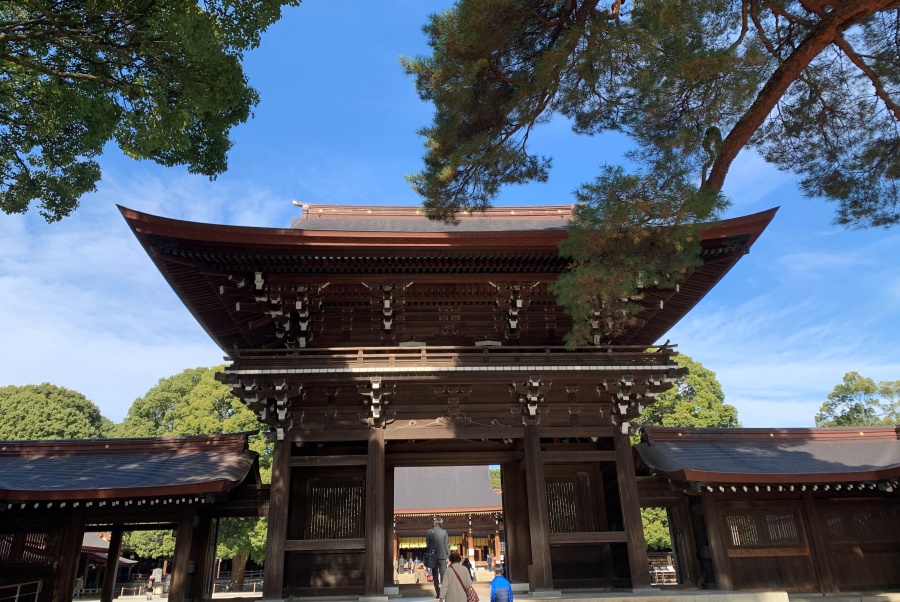
Located in Tokyo, the Meiji Jingu shrine is devoted to the spirits of Emperor Meiji and Empress Shken.
The forest surrounding the shrine has about 170,000 trees. This area is peaceful enough to allow visitors to pray and shop for traditional items.
Meiji Shrine is a large wooded area that can be found near the JR Yamanote Line’s Harajuku Station. The area features walking paths that can be used for a relaxing walk.
The shrine was completed in 1920 and was dedicated to the emperor and Empress Shoken. However, it was destroyed by the Second World War.
Emperor Meiji was the first modern emperor of Japan. He ascended to the throne in 1867 following the Meiji Restoration.
Following the Meiji Period, Japan became a modern country that joined the world’s major powers.
The main complex of the shrine is located about 10 minutes walk from both the northern and southern entrances of the station.
The entrance to the complex is marked by a massive torii gate. The forest surrounding the site makes the place feel peaceful.
The trees that make up the forest at the shrine were donated from regions across Japan.
The buildings at the center of the complex have an air of calm that’s different from the surrounding city. There are also areas where visitors can perform traditional Shinto activities.
One of Japan’s most popular shrines, the Meiji Jingu attracts over three million visitors during the first day of the New Year. This event is also known as hatsumode.
Near the Harajuku station’s entrance is the Meiji Jingu Museum, which was opened in October 2019.
The museum at the Meiji Shrine features various objects from the emperor’s personal collection. Some of these include a carriage used by the emperor when he rode to the Meiji Constitution’s declaration.
The Inner Garden, which is located in the southern portion of the shrine, is very popular during the spring and summer.
It’s named after Kiyomasa’s Well, which was dug around 400 years ago. It was visited by the emperor and Empress during their time.
Here’s what Ruby Lib thought about their trip to this place: “Such a beautiful place in the midst of Tokyo. Shady, quiet and calm. Trees always greenish event in autumn. Enter to free. Sake and winery panel are good for photography. The shrine is located in the deepest where you can pray and make merit. Too many tourists. You must take a time to explore this place.”
Another visitor, Elias Chelala, has this to share about their last visit here: “A Shinto shrine located near Shibuya that is definitely worth visiting. When I went in early summer they had an assortment of bonsai trees on display. It’s free to enter and walk around the surrounding Shrine and garden. You should also check out Yoyogi park when you visit. There were lots of people on the weekend enjoying drinks and having a picnic.”
Meanwhile, here’s another satisfied guest, Andre Bastary, has to say about their experience visiting here: “A popular Shinto temple in the middle of a forest within Tokyo, a nice and quick stroll to the temple though during the summer the heat can be dangerous. During my visit there was a engagement photoshoot happening as well, so it was a nice additional views to Japanese traditional wedding style. The main gate is massive and visitors can purchase lucky charms for many occasions. There’s one for education, one for career, and even the lucky draw using sticks that you might see in Japanese movies or anime.”
Address: 1-1 Yoyogikamizonocho, Shibuya City, Tokyo 151-8557, Japan
Website: https://www.meijijingu.or.jp/
Opening Times: 6:40 am – 4 pm (daily)
Price: Free
Google Map Location:
Motonosumi-Inari Shrine
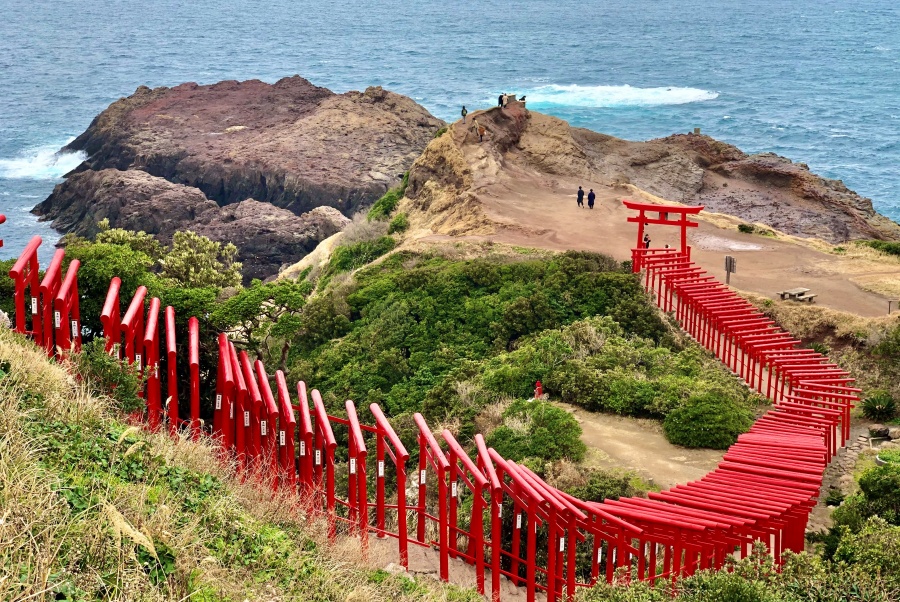
Set against the backdrop of the Sea of Japan, the Motonosumi-Inari Shrine is a prominent place in Nagato, Yamaguchi.
The vermillion-colored gates at the White Fox shrine contrast nicely with the sea’s bright blue. It’s believed that the prayers offered here will bring success in business and travel.
The Motonosumi Shrine is located in northern Japan’s Yamaguchi Prefecture. This location and its numerous attractions have gained its popularity due to their beauty.
The White Fox shrine got its name from a man who saw a depiction of a white fox inside his hospital bed. He then established it in 1955.
Unlike other famous shrines in Japan, the Motonosumi Shrine doesn’t have massive structures. Instead, its main hall has a small structure.
There are no structures on the end of the gates. Instead, the torii gate, which is the highest structure on the site, is located on top of the shrine. It’s believed that good fortune comes from those who successfully throw coins into the box.
Here’s what Ralf Blaich thought about their trip to this place: “This place is really unique. The red tories add a nice contrast to the rocks and the ocean. Plenty of parking lots and some restaurants are opposite of the shrine. The road leading to the shrine is offering nice views of the ocean.”
Another guest, Kristin P, shared their insight about the location, saying: “While this shrine is a little bit out of the way from other tourist attractions, this shrine is worth the visit to see the 123 bright tori gates along the water. There is quite a large pay parking lot right at the shrine, plus a gift shop and clean bathrooms.”
A satisfied visitor, Giami Lee, has this to share about their last trip here: “Stunning view of the hundreds (or thousands?) of Torii lined up along the cliff! I didn’t come at a right time cause the sunshine wasn’t at a right direction and shades in the photo which didn’t look great. but what I saw from my eyes was definitely amazing! expect to spend 1-2 hours here to take great pictures and enjoy the scenery!”
Address: 498 Yuyatsuo, Nagato, Yamaguchi 759-4712, Japan
Website: https://motonosumi.com/
Opening Times: 5:30 am – 5:30 pm (daily)
Price: Free
Google Map Location:
Nezu Shrine

The Nezu Shrine is located in Tokyo. It is one of the oldest temples in the city. Its annual festival is known as the Bunkyo Azalea Festival.
The main shrine and other temples have vermillion-hued torii gates that lead to the various pathways. Azalea gardens are also featured here.
It’s believed that the shrine was built around the 1700s. According to indigenous beliefs, it was created by a priest named Takeru no Mikoto for the deity known as Susanoo no Mikoto.
The various pavilions in the complex were constructed under the authority of Tsunayoshi Tokugawa between 1709 and 1683.
The main areas of the shrine are the kagura-den and the hall with red lacquer. The other areas are the worship hall and the offering hall.
The shrine has two gates known as Romon and Karamon. Its massive grounds are filled with various vegetation, including a carp pond and azaleas.
The area where the shrine is located is known as the Bunkyo ward of Tokyo. This historic site has plenty of historical significance as most of the structures in the area were constructed during that period.
There’s a rock on the main gate that features the names of prominent writers such as Ogai Mori and Soseki Natsume.
Here’s what Prapulla B thought about their trip to this place: “Nezu shrine is a beautiful shrine with more than 100 Tori gates mesmerizingly built. It’s a huge shrine in the midst of the forest ? and hydrangeas.
It’s a must visit place during the hydrangeas season before rainy season. Picturesque spot for the traditional Japanese kimono ? costume.”
Another guest, Marie Apsay, shared their experience visiting this spot: “I came to visit a bit late, the azaleas were past their peak and were all kinda green which was really sad. The layout of the garden’s really beautiful though, and I assume it would be awesome when the azaleas are in full bloom. It’s also located in Tokyo so getting there’s easy enough. A very beautiful shrine to visit.”
Jennifer Murphy, a satisfied guest, shared their experience about their last visit here, saying: “If you’re available to go in April, the azalea garden (¥200) makes it even more picturesque. The shrine, torii gates, and koi pond conjure up what I think of as traditional Japan. It’s a nice little oasis in the middle of the city. I’d recommend 30-45 minutes to walk around, take pictures, and enjoy.”
Address: 1 Chome-28-9 Nezu, Bunkyo City, Tokyo 113-0031, Japan
Website: http://www.nedujinja.or.jp/
Opening Times: 6 am – 4:30 pm (daily)
Price: Free
Google Map Location:
Nogi Shrine
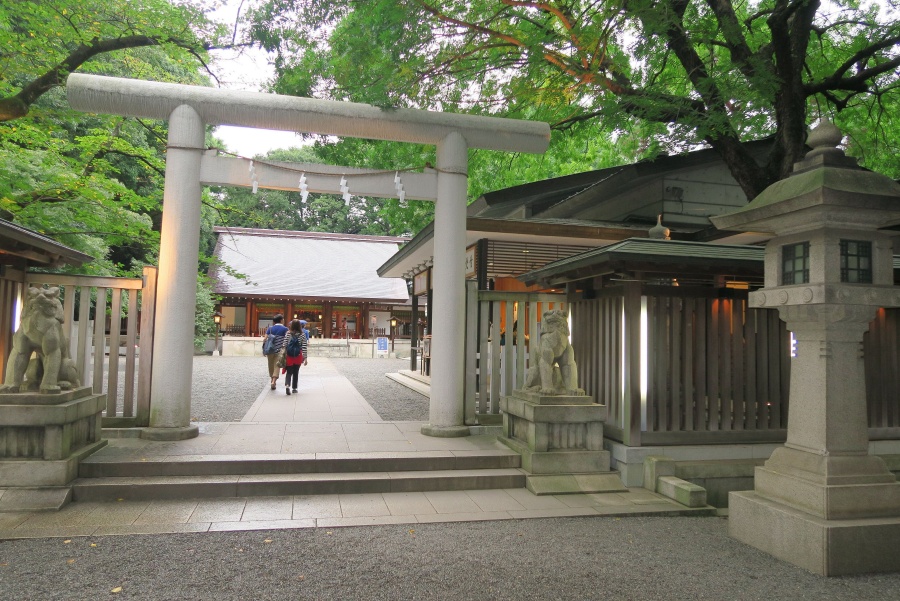
The Nogi Shrine is a prominent location in Tokyo. It is known for its peaceful atmosphere and the education of Nogi Maresuke.
Although the shrine grounds can be visited anytime, the general’s house near the shrine is only open for viewing once a year.
The shrine grounds are filled with vermillion gates and beautiful gardens. The flea market is held on the fourth Sunday of the month.
The shrine was established in 1923 in honor of Nogi Maresuke and his wife.
He was one of the privileged few who was sent to Germany to study modern warfare during the late 1880s.
He felt that he had a responsibility to the Japanese people who died during the Siege of Port Arthur. He tried to convince Emperor Meiji to let him commit suicide.
He used the skills he learned in Germany to help win in the First Sino-Japanese War and the Russo-Japanese War.
After learning about Emperor Meiji’s death in 1912, Nogi and his wife committed suicide by slitting their throats using a knife.
Following his suicide, the Maresuke family built the shrine inside their home. It is only open twice a year, however, they can still see the beautiful view from their balcony.
Here’s what Anouk Rossen thought about their trip to this place: “Very nice little surprise-shrine in the middle of Nogizaka-area! ^^ We just happened to walk past and were surprised by the calm un-tokyo-like atmosphere and feeling of the place. Recommend to visit for those who feel like getting away from the city to get a breather but don’t actually have time to get out of the city xD
They sell various charms, goshuin (shrine stamp), and when we were there there happened to be a traditional Japanese wedding being held which was cool to see ^^.”
Another guest, Lemis AN, has this to share about their last visit here: “I’m a huge believer of spirits as well as going to shrines and praying. I loved this shrine I hope to go again when the construction is over as it was extremely noisy and I went yesterday. Japanese shrines or any place of worship is VERY PEACEFUL. Loved it and will come back again.”
Meanwhile, Ingrid Chou, a satisfied guest shared this about their experience on their last visit here, saying: “Worth a visit in autumn as there is bunch of red leave in the garden.
The Nogi General (active in ww1 and ww2) can pretty much represent the spirit of Japanese Bushido culture. He is also the 3rd general administrator in Taiwan during the Japanese colonization. As a Taiwanese, the shrine is really a great place to have a look on Taiwan history.”
Address: 8 Chome-11-27 Akasaka, Minato City, Tokyo 107-0052, Japan
Website: https://www.nogijinja.or.jp/
Opening Times: 6 am to 6 pm (daily)
Price: Free
Google Map Location:
Sensoji Temple

Located in Tokyo, the Sensoji Temple is one of the oldest temples in Japan and is known for attracting millions of visitors each year.
This temple is named after the goddess of mercy, Asakusa Kannon. It’s located in Nakamise, Tokyo. Take a walk through the area’s famous shopping street and visit the various attractions in the temple.
Sensoji is a popular temple in Asakusa. It is known for its colorful and colorful displays.
According to a legend, two brothers once fished a statue of Kannon out of the Sumida River. Even though they returned it, it always returned to them.
The brothers then built a temple near the goddess of Kannon. In 645, this structure was completed, making it Tokyo’s oldest temple.
The shopping area Nakamise follows the outer gate of the temple. It then leads to the Hozomon, the temple’s second gate.
The street has a history of multiple centuries. Aside from traditional sweets, there are also local snack bars selling Asakusa-themed products.
Beyond the gate is the main hall of the temple, which houses five long pagodas. The Asakusa Shrine, which was constructed in 1649 by Tokugawa Iemitsu, is located on the other side of the street.
Various events are held in the area during the year. The biggest event in this area is the Sanja Matsuri, which is held in May.
Various events are held in August to celebrate Asakusa. One of these is the Samba Carnival, which involves the use of wooden paddles.
The temples in Senso-ji have been visited by pilgrims. The main entrance to the complex is the Kaminarimon Gate.
This massive paper lantern features a depiction of lightning and thunderclouds in vivid red and black.
Behind the Kaminarimon is the Nakamise-dori, which carries goods and souvenirs. A five-story pagoda and the main hall are also within the complex.
The Senso-ji Temple is visited by many tourists each year. To accommodate the crowd, many traditional restaurants and shops nearby have been established.
The Nakamise-Dori is filled with shops selling a variety of souvenirs, such as belts and umbrellas, and Japanese sweets.
There are also o-mikuji stalls nearby the temple. They offer spiritual advice and answers to their questions.
These helpers are known as katsuri or shake sticks from metal containers. They retrieve the corresponding answers from one of the boxes.
The Senso-ji temple grounds are maintained in a Japanese-style garden. It is usually the focus of the Sanja Matsuri festival.
The Sanja Matsuri Festival is held each year in late spring. It involves closing the streets surrounding the temple.
Here’s what Mary M Rodriguez thought about their trip to this place: “Beautiful, colorful, and visually distinctive temple in all of Tokyo, maybe even in all of Japan. An absolute must see to anyone visiting the city. The temple grounds are accessible 24/7( free), beautiful day and night. By day, the temple is full of people in traditional kimono, and the shopping street in front has some genuinely cool and unique souvenirs. Very spiritual and amazing temple.”
Another satisfied guest, Caitlin Meadors, shared their experience visiting here: “Great temple! It’s always nice. On this day there was a Hagoita Festival and festival food, which was lovely! Many festivals and events are held at this temple…so check before you go.”
Meanwhile, Jacob Newcomb, has this to say about their experience visiting here: “The most beautiful, colorful, and visually distinctive temple in all of Tokyo, maybe even in all of Japan. An absolute must see to anyone visiting the city. The temple grounds are accessible 24/7, and it is beautiful both day and night. By day, the temple is full of people in traditional kimono, and the shopping street in front has some genuinely cool and unique souvenirs I haven’t found in other parts of Tokyo.”
And lastly, based on Benjamin Baker’s more recent trip, they share their experience here: “Very cool architecture and overall experience. I’m sure it would have been 50x more busy if it weren’t for COVID. There were closed stores and booths everywhere nearby! I’m sure when the virus is over this place will be hopping and super cool to visit. Though it was nice to see it in more of a serene setting versus tourists everywhere. There were signs in English that describe certain buildings and what you’re supposed to do when you are in the temple. I’m sure there’s some more history go this temple that the signs didn’t relay, it may be good to join a guided tour if you’re after the historical aspect.”
Address: 2 Chome-3-1 Asakusa, Taito City, Tokyo 111-0032, Japan
Website: https://www.senso-ji.jp/
Opening Times: 6 am – 5 pm (daily)
Price: Free
Google Map Location:
Shitennoji Temple

Shitennoji is a historical temple in Japan that was established by Prince Shotoku in 597.
The temples were always rebuilt to replicate the original 6th-century designs.
The admission fee to the inner precincts is paid for both the treasure house and the Gokuraku-jodo Garden.
The inner portion of the temple has a pagoda that can be ascended and enters the Main Hall, which is named after Prince Shotoku.
The treasure house features various valuable items taken from the temple, such as paintings. The garden also has a depiction of the Western Paradise of the Buddha.
The Shitennoji Temple was established in 597. It features a five-story pagoda, a treasure house, and a Japanese garden.
The complex has various lecture halls, prayer rooms, and gates. There are also statues of Prince Shotoku and the goddess of mercy, Kannan, in the Main Hall.
Here’s what Edith Aszalos thought about their trip to this place: “It’s an amazing place. You can walk around and sit on bench as well. Even though the temple closes, you can still take amazing pics and see surroundings. Btw, it closes at 4:30 PM. Entrance fee is 300 Yen. Enjoy!”
Another guest, Tobias Gehrke, shared their experience visiting here, saying: “Beautiful temple areal. Typically Japanese in the sense that it is superbly maintained and tidy. Architecturally pleasing. Well worth a visit and good contrast to vibrant metropolitan Osaka.”
TS C, a very satisfied guest, shared their insight about their last trip here: “What a great way to start off the New Year! (Not many shops open…..) It’s a Japanese tradition to visit a Shrine or a Temple on New Year’s Day?
This is a Buddhist temple. I believe it is the first Buddhist temple in Japan. I am no historian so you can google all about it but it’s 1400 years old… That’s old.
Captain Google…. wasn’t 100% correct about direction. How come we entered thru the side door??? We missed the market!
I guess it’s good. We missed the traffic as well ;). I love Japan. Everyone is so disciplined. Just follow the crowd, you will become expert and will not get lost. It’s a real temple with real monks doing their prayers. Closes at 4pm sharp. Go early. Enjoy. Happy New Year.”
Address: 1-11-18 Shitennoji, Tennoji Ward, Osaka, 543-0051, Japan
Website: http://www.shitennoji.or.jp/
Opening Times: 8:30 am – 4 pm (daily)
Price: 3 USD
Google Map Location:
Taikodani Inari Shrine
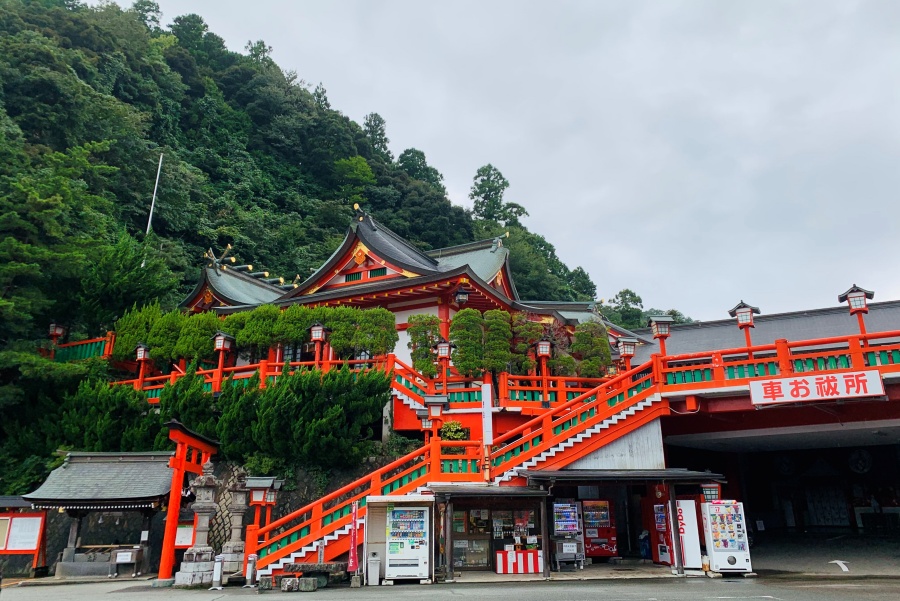
The Taikodani Inari Shrine was constructed in the 18th century to protect the spirits of the Tsuwano Castle.
Today, people come to the Taikodani Inari Shrine to pray for good fortune and good harvests. The entrance is located on the southern part of Tsuwano’s old town.
A tunnel leading to the main hall and former main hall is used to enter the shrine grounds. There are also large sacred straw ropes hanging on the front of the hall.
One of the five greatest Inari shrines in Japan, the Taikodani Inari Shrine was constructed in the 17th century. Its approach road is through a tunnel of over 1,000 torii gates.
The shrine also hosts various seasonal festivals, which attract millions of visitors each year. They can also pray to the deities and ward off evil.
From the south, you can see the huge vermillion torii that marks the road to Tsuwano. From there, you can see the valley below and the cluster of buildings within the trees.
The town’s biggest attraction is the Inari Shrine, which is located in the center of Tsuwano. This is also the fifth largest in Japan.
It’s possible to visit the shrine from the road, but the best way to get there is on foot through the tunnel that leads up to the hill.
The Taikodani Shrine was established during the Edo Period.
Inari is commonly associated with rice, but the concept of Taikodani Inari was established for different reasons.
One notable example is the remains of Tsuwano Castle, which can be seen on top of Mount Shirayama.
The concept of Inari was to protect the area from evil forces that might arrive from the northeast.
The shrine was exclusively for vassals and lords. The public was allowed to visit it in the 1870s following the abolition of the domainal system.
Another unique feature of the Taikodani Inari Shrine is that its name is written in Chinese characters.
A person who lost the key to a castle was punished to commit ritual disembowelment.
The person was kept busy praying all day at the shrine, and when the sentence was finally carried out, he was spared.
A good time to visit the shrine is during the Shunki Taishi, which is held in May.
Unlike Buddhist temples, Taikodani does not charge an entrance fee. This is because they do not have access to the funeral business, which means they are left with few sources of income.
Oharae are requested for various reasons, such as wanting to start a new venture or even for an old year.
The standard fee for an Oharae ceremony is around 3,000 yen. During the Shunki Taisai, ceremonies are held almost continuously throughout the day.
One of the secondary shrines in the area has a dance called Mikomai, which is performed throughout the day. At the end of the performance, she comes to the entrance and blesses all those standing there.
Underneath the main building, there is a small shrine that is designed to bless cars.
Although traffic safety ceremonies are common in many temples and shrines, I have never seen a purpose-built shrine like the Taikodani Inari.
Here’s what Sig Freud thought about their trip to this place: “It’s no wonder Tsuwano is known as “Little Kyoto!” This Shrine and location are absolutely gorgeous! Well worth the trip, regularly repaired and well maintained.
This Inari Shrine is considered one of the top five in Japan!”
Address: 409 Ushiroda, Tsuwano, Kanoashi District, Shimane 699-5605, Japan
Website: http://taikodani.jp/
Opening Times: 24 hours (daily)
Price: Free
Google Map Location:
Todaiji Temple
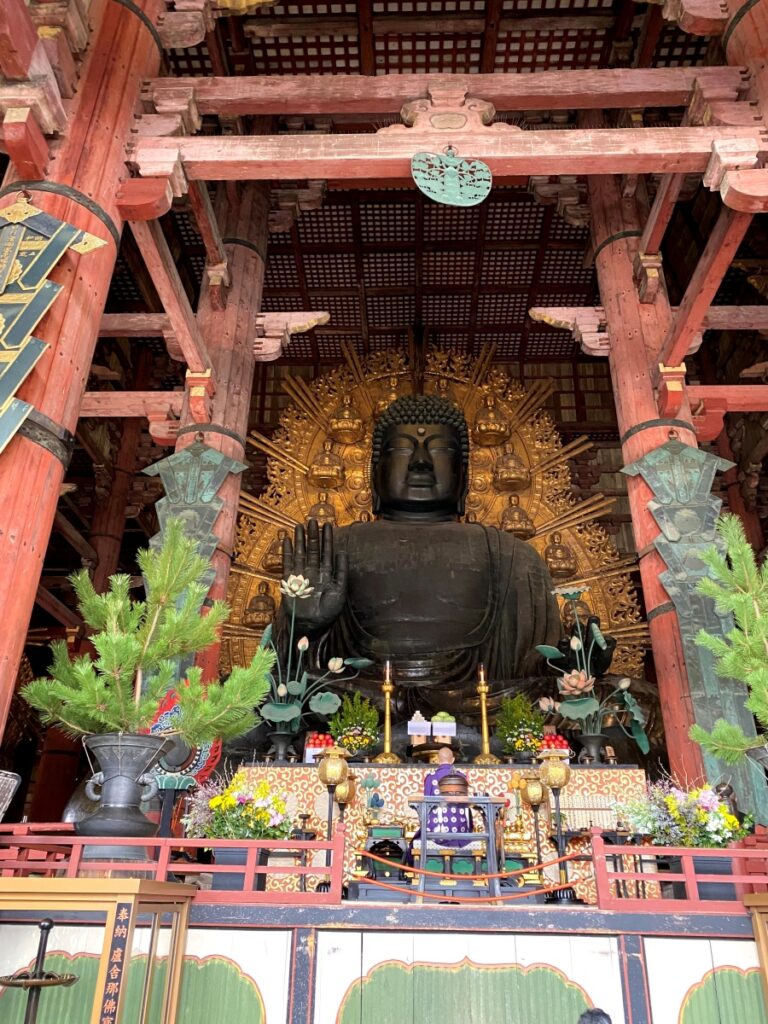
The Great Buddha Hall in Nara was constructed in 752 by Emperor Shomu. It features a statue of Rushana Butsu.
This is a 14.84-meter bronze statue of the Cosmic Buddha, which was originally built in Japan for the Dalai Lama.
In 784, Emperor Kammuni moved the capital from Heij-kyo to Nagaoka in order to escape the influence of the powerful temples in the area.
Although the Todai-ji Temple was not part of the imperial family, it was still influential due to its links with the powerful Fujiwaras.
However, Todai-ji Temple also had ties with the imperial family, so it continued to influence the court.
The Todai-ji Temple was one of the seven great temples of Nara, and it remained influential throughout the ages.
The Daibutsu Hall contains numerous sculptures, and these can be found in other parts of the temple.
Located in Nara, the Todaiji Temple is one of the city’s most popular attractions. The Daibutsu-den is where the massive Buddha statue is housed.
The main structure in the temple is the Nandaimon Gate, which has numerous structures. There are also other buildings within the complex such as the Todaiji Museum and the lecture hall.
Nandaimon Gate is the gateway to the Toijida temple, and it features massive wooden statues of the god or nio.
The Todaiji Museum is a modern facility that houses various religious and statuary pieces from the Todaiji Temple.
The Great Buddha Hall in Daibutsuden houses the biggest bronze statue in Japan, which is a depiction of the Cosmic Buddha.
The casting of the Buddha failed several times before it was finally achieved in 752.
The original 8th-century statue was destroyed in various earthquakes and fires. It was then re-cast again after being damaged by fire.
On New Year’s Eve and New Year’s Day, the upper doors of the temple are opened, allowing people to pray to the Buddha from outside.
The Kaidanin, which is located just west of the Daibutsuden, was established in 754. It features several clay statues of the Four Heavenly Kings and Shitenno.
The Todaiji Bell Tower, which is believed to have been constructed by the Zen priest Yosai, was first built in 1210.
There are two sub-temples of Todaiji that are located on the hill above the town. The Nigatsu-do is where the annual Omizutori purification rituals are held.
On the day of the New Year’s Eve, priests carry flaming torches to the top of Nigatsu-do, which is believed to bring good fortune to the year.
The Sangatsudo features a number of important statues, including a depiction of a deity known as Fukukenjaku Kannon.
This image is surrounded by several other statues, including those of Gakko-Bosatsu and Nikko-Bosatsu.
Todaiji is located north of Kofukuji and is about 30 minutes from Kintetsu Nara Station.
From both the Nara City Loop Line and the Todaiji Daibutsuden bus stops, there are numerous buses that run to the temple.
Here’s what Loanloan Nguyen thought about their trip to this place: “The temple is inside Nara park, very nice and peaceful . When you walking to the main hall, you can see many deers and please be careful as they are a bit hungry. The park is very beautiful during autumn.”
Meanwhile, another guest, Melanie Smith, has this to share about their most recent trip here: “Beautiful temple complex. It was very crowded on a Saturday, even with the pandemic ongoing. I can imagine when there are international tourists that this place becomes quite overrun.
I purchased tickets to ended at the museum near Nandaimon gate. You can buy a ticket to enter the museum and the Buddha, which means you won’t need to wait in line to buy at ticket at the entrance to the temple itself.
Some of the features of the temple are closed due to COVID- for example the large hole in one of the pillars that you can normally crawl through it closed.”
Another guest, Christian Ardito, has this to share about their experience visiting here: “The main attraction in Nara! The Todai-Ji temple is amazing. The great Buddha statue, called Daibutsu by the Japanese, is the largest bronze statue of Buddha in the world. Pictures do not do it justice – it is impressive in person, and by the way, it is larger than the monumental Buddha in Kamakura. What you may not realize is that there are several other giant statues – all very impressive – inside and outside the main hall. Simply amazing.”
Meanwhile, Annie Sobol, a very satisfied guest, has this to say about their most recent trip here: “This is a “must see” temple in Nara. Photos are allowed! The Buddha is ginormous and incredible to see. Photos cannot show the true massiveness of this temple.
Tōdai-ji was the chief temple in the Kokubun-ji system, it was a center for rituals for the peace of the nation and prosperity of the people; it also functioned as a center for the training of scholar monks who studied Buddhist doctrine.”
Address: 406-1 Zoshicho, Nara, 630-8211, Japan
Website: http://www.todaiji.or.jp/
Opening Times: 9:30 am to 5 pm (daily)
Price: 6 USD
Google Map Location:
Toshogu Temple

The Toshogu Temple is a spectacular structure located in Nikko, Japan. It features a stunning collection of carved and colored buildings.
The highlight of the complex is its five-story pagoda, which is adorned with carved objects. There are also various shrines and storehouses within the temple.
The beautiful works of Japanese artists and woodworkers can be seen throughout the temple grounds.
The Toshogu shrine is a magnificent structure that honors Tokugawa Ieyasu, who was the founder of the Tokugawa Ieyasu.
Originally, the Toshogu mausoleum was a simple structure. It was then expanded into a spectacular structure during the 17th century.
The complex has over a dozen buildings and is situated in a beautiful forest. The intricate designs and materials used for its construction were only used in Japan.
It’s widely believed that the Toshogu contains both Buddhist and Shinto elements. During the Meiji Period, this was common when both religions were separated.
Although some parts of the country had Buddhist and Shinto sections, the two religions were still mixed at Toshogu.
One of the most notable buildings at Toshogu is a five-story pagoda located in front of the main entrance gate.
The main pillar of the pagoda is located ten centimeters above the ground, which is an unusual feature that was designed to combat the wood’s longevity.
Before entering the complex, visitors are required to pass through a group of storehouses. These storehouses are usually well-built and ostentatious.
One of the most popular wood carvings that can be found in the storehouses are the Sozonozo elephants and the Elephants.
The Beyond Yomeimon building is the main shrine structure. It features a praying hall and a hallway connecting it to the main hall.
The hall named after Ieyasu and other prominent figures are dedicated to the spirits of three individuals, namely Toyotomi Hideyoshi, Minamoto Yoritomo, and Yasuko Yamauchi.
The main gate of the complex is located at the Sakashitamon Gate, which bears the famous carving of the sleeping cat Nemurineko.
Steps leading to the mausoleum take about five minutes to ascend. After passing through the woods, the visitors can see the prominent carvings in the mausoleum.
In 2015, a new museum was opened to commemorate the 400th anniversary of Ieyasu’s death.
Inside this modern building, visitors can see various personal effects that the former shogun had.
Here’s what NervousBunnyGaming thought about their trip to this place: “The most beautiful temples I’ve visited in Japan so far. The protection of these buildings is immaculate and they weren’t burnt down in some fire and rebuilt in the 1900’s they are actually four hundred years old and are just taken care of and repainted very well. I could feel the history breathing in and out of this place. Tokugawa’s treasures were well kept and I just can’t describe in clear words how happy that I, a history lover, was to to be able to touch and be so close to something so old and well taken care of for the public. I think Tokugawa would be proud at how many people love and respect his family’s heirlooms and resting places.”
Another guest, #TheFrugalTraveller Leah Lacsina, has this to share about their most recent visit here: “One of the oldest shrines in Japan. You can explore the insides of the shrine by paying 1800++ yen.
Inside the shrine, you will be able to see the 3 monkeys, the 12 astrological sign plus, the sleeping cat and the Crying Dragon which is said to give you goodluck.
If you are lucky (like the time we went there) a monk prayed for us via a special prayer.”
Meanwhile, Christian Ardito, a very satisfied guest has this to share about their last visit to this spot: “Nikko is a lovely little town with lots to see – perfect for a day trip. Tosho-gu is probably the main attraction. You can walk there from the JR station or take a bus if you don’t feel like walking. I recommend walking since we are talking about less than 4 miles and there’s lots to see. The complex is absolutely gorgeous with tons of impressive shrines and structures. One of my favorite during this first trip to Japan.”
Address: 2301 Sannai, Nikko, Tochigi 321-1431, Japan
Website: https://www.toshogu.jp/
Opening Times: 8 am – 4 pm (daily)
Price: 12 USD
Google Map Location:
Tsurugaoka Hachimangu
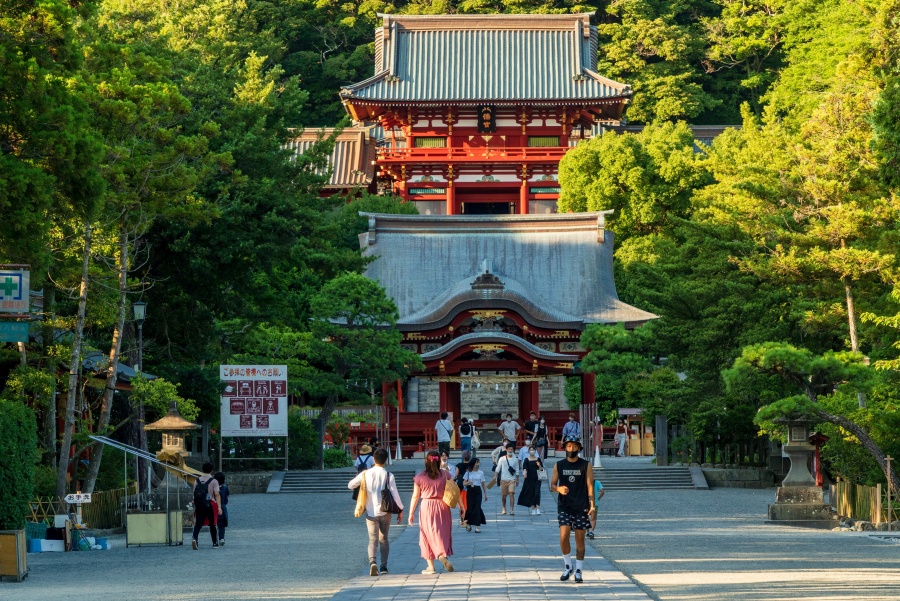
Located in Kamakura’s center is the Tsurugaoka Hachimangu, which is regarded as the most important Shinto shrine in the area.
Its main shrine is located in a typical Edo-period structure and can be reached through a long path that’s been lined with torii gates.
This shrine features a variety of facilities, including a large pond, a performing stage, and various smaller shrines. It also has a shrine-owned garden.
It was originally founded in 1063 by the late Minamoto Yoriyoshi. It was then enlarged and moved to its current location in 1180 by the late Yomoto Yoritomo.
The main attraction of this shrine is its dedication to Hachiman, the god of the Minamoto family. The deified spirits of Emperor Ojin, who was also known as Hime-gami, are also enshrined here.
The shrine is easily reached through Kamakura’s waterfront, which can be accessed through multiple torii gates.
The main hall of this shrine is located on a terrace. It features a small shrine museum, which holds various relics owned by the shrine.
Two ponds are located beside the main entrance. These ponds represent the various clans of the Minamoto clan, as well as the rival clans of the Taira Clan.
A garden known for its peonies is also located near the pond. It is open during both spring and winter, and costs 500 yen to enter.
Various events are held each year at the shrine, and it is regarded as one of the most popular shrines in the country during the New Year holidays.
In April and September, archers can be seen riding a yobusame through the main approach to the shrine.
Here’s what Mahady Hasan Rayhan thought about their trip to this place: “Good place. There is a large buddha statue purely made of gold. The observatory deck (a small place where you can enjoy the nice ocean view) is also good. Also there is a hydrangea flower garden. It may cost you some to enter the hydrangea garden.”
Another guest, James Lewis, has this to share about their most recent trip to this spot: “If you’re looking for a little get away from Tokyo, but still want to experience a wonderful piece of Japan’s rich history, Kamakura, the old capital of Japan is just the right spot. There are many fun things to do and eat along the way towards the temple. And the temple itself is beautiful.”
Meanwhile, Onuma Kurosaka, a very satisfied guest has this to share about their most recent trip here: “Surugaoka Hatchiman Shrine This is an Beautiful ancient temple in Kamakura City, built before Kamakura became the capital in the past, probably over a thousand and nine hundred years old because of the Buddha image inside. With Guanyin And many other ancient gods that are thousands of years old Take photos only outside Temple area only But inside the cubicle, including the museum showing antiques.”
Address: 2 Chome-1-31 Yukinoshita, Kamakura, Kanagawa 248-8588, Japan
Website: https://www.hachimangu.or.jp/
Opening Times: 6 am – 8:30 pm (daily)
Price: Free
Google Map Location:
Usa Shrine

The Usa Shrine of Osaka, also known as the Usa Shrine, is located in the center of the Kunisaki Peninsula. It is one of the many shrines in Japan that is dedicated to the god of war and archery, Hachiman.
The main hall of the shrine is a designated national treasure, and its design is based on the Hachiman-zukuri style.
The various parts of the shrine are located in a covered corridor, which makes them hard to see clearly from.
The shrine has various structures such as a main hall, a lower shrine complex, and a treasure hall.
Visitors usually enter the shrine through its west or north entrance. It has a wide area lined with shops selling local products.
The Omotesando Avenue follows the main shrine approach. It has a vermilion torii gate leading to the treasure hall.
The treasure hall features various cultural relics, such as a ceremonial percussion instrument with peacock emblems.
At the west entrance, there is a beautiful bridge called Kurehashi. Although it is usually not possible to cross it during a festival, the doors are usually opened once in ten years.
Upon entering the complex, the visitors are first taken to the three main hall’s dedicated to Hachiman.
After entering the main hall, the visitors proceed to the lower shrine complex, which also has three main hall’s dedicated to the same deity.
The Usa Shrine is a Shinto shrine located in Japan. It is one of the main locations for shrines dedicated to Hachiman.
The main shrine here was built in the 8th century. It has a unique Hachiman-zukuri style structure that features a lotus pond, a noh theatre stage, and various other structures. The treasure hall has a lot of musical instruments and paintings.
The main hall of the shrine is a designated national treasure, and its roof is connected to another building. This structure is known as a Hachiman-zukuri type of shrine architecture.
The Usa Shrine has a large compound. It has an upper and lower shrine complex, as well as a treasure hall and various other buildings.
Visitors can usually reach the shrine’s north or west entrance. There are a number of shops selling local products along its path.
The path follows the Omotesando, which is the main shrine approach. There are also shops along its path that sell local products.
The treasure hall has a variety of cultural artifacts related to the shrine. One of these is a percussion instrument that was marked with peacocks.
Here’s what Maya Sause thought about their trip to this place: “Such a lovely shrine! It’s the second most prestigious shrine after Ise Shrine in Mie. Part of it was under construction, but it was still nice to walk around the quiet area and snack at the places lined up outside the gates. Not as spacious as Ise Shrine, but still definitely worth a visit.”
Another guest, Nadya Dee, ,has this to sharre about their experience visiting this spot: “Usa-jingu in Oita is believed to be the first Shinto shrine in Japan in which Hachiman-ji, the god of military power, was enshrined. A Buddhist temple called Miroku-ji is also built next to it, which makes it the first shrine-temple ever.
The main hall and the Kujaku Monkei are designated amongst Japan’s National Treasures.
When visiting, be sure to place your hands on the large camphor tree there to wish for success.”
Meanwhile, Todd Fong, a very satisfied guest has this to share about their experience during their last trip here: “The significance of Usa Jingu is not well known by foreign visitors but when you arrive here you understand what an important shrine it is. It is very large and the buildings look like they were recently rebuilt but actually they are centuries old and just very well maintained. Come in the fall to enjoy the lovely autumn colors.”
Address: 2859 Minamiusa, Usa, Oita 872-0102, Japan
Website: http://www.usajinguu.com/
Opening Times: 5:30 am – 9 pm (daily)
Price: Free
Google Map Location:
Yasukuni Shrine
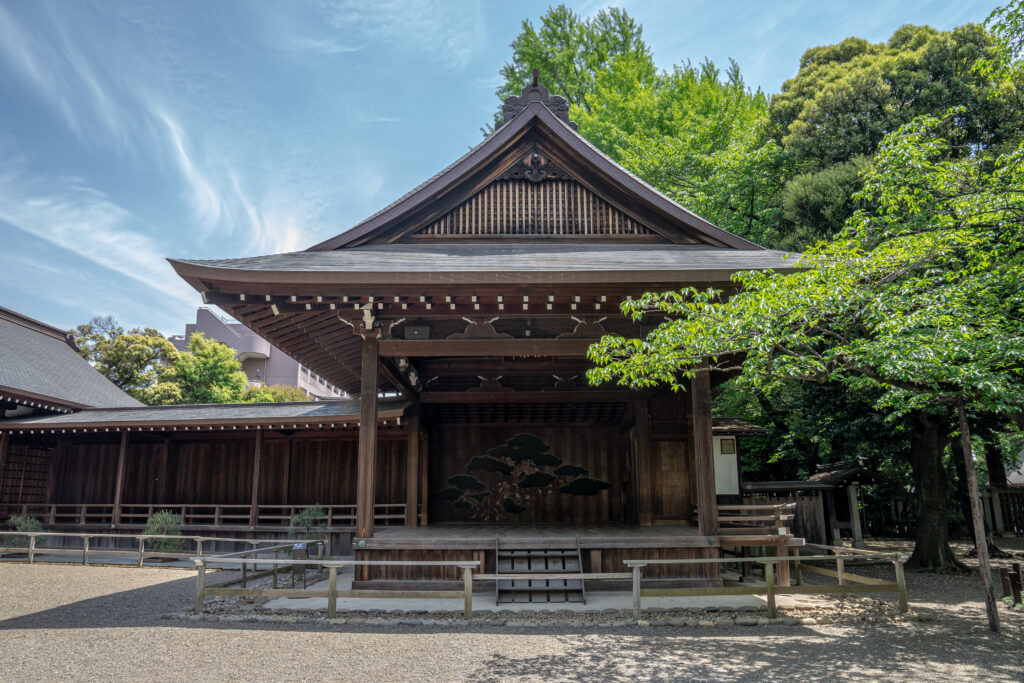
The Yasukuni Shrine was established over 150 years ago to honor the sacrifices of the Japanese soldiers who died in World War I and II. It also honors the souls of those who died in other wars.
The Yushukan Temple grounds are peaceful and have various festivals and rituals honoring the dead.
The origins of Yasukuni Jinja can be traced back to a shrine known as Shokonsha, which was established during the Meiji era.
On January 27, 1874, Emperor Meiji visited the shrine and offered his condolences to the soldiers who died for their country.
The Yasukuni Shrine was established to honor the individuals who gave their lives for their country. It was named after Emperor Meiji.
More than 2,466,000 souls have been placed inside the Yasukuni Shrine since it was established. These souls are those of the soldiers who died during various national crises, such as the Sino-Japanese War and the Meiji War.
Even though they may have different social standing, these people are considered to be equal to the revered elders of the Yasukuni Shrine.
In accordance with Japanese tradition, Yasukuni Shrine officials conduct rituals to show their respect for the dead.
Twice a year, His Majesty the Emperor dedicates offerings to the fallen soldiers at the Yasukuni Shrine.
The relationship between the Imperial Family and the Yasukuni Shrine is deep. As a central institution, it receives about five million visitors a year.
The origins of the Yasukuni Shrine can be traced back to a different shrine known as Shokonsha, which was established in the second year of the Meiji era.
During the Meiji era, Japan was in the process of transforming itself into a modern unified state. Before that period, it had been isolated from the outside world for 250 years.
When the West pressured Japan to open its doors, it led to Japan’s instability. The Tokugawa Shogunate was able to maintain its grip on the country’s political affairs for over 260 years.
Despite the lack of power, the Shogunate was able to maintain its grip on the country’s political affairs. Eventually, Japan was able to establish a modern unified state under the Emperor’s leadership.
Upon Japan’s establishment as a modern state, the country suffered from an unavoidable conflict known as the Boshin War.
Meiji wanted to honor the memory of the soldiers who gave their lives for Japan.
Shokonsha was the first shrine to be established following the Meiji era. In 1879, it was renamed as Yasukuni Jinja and became an Imperial Shrine of Special status.
The name Yasukuni was selected by the Emperor to refer to the Shrine’s goal, which was to maintain peace in the nation.
Many of the martyrs who died at the Yasukuni Shrine were those who fought in domestic conflicts.
The outbreak of the Second World War signified the beginning of Japan’s modern era. Many of the individuals honored at the Yasukuni Shrine were involved in the war effort.
Some of the conflicts that were fought in the shrine include the Russo-Japanese War, The Great East Asian War, and the First World War. Currently, over two million individual souls are enshrined at the facility.
Not only are the dead soldiers honored at the shrine, there are also the souls of civilians and school girls who participated in the relief operations during the war. Many of them died in Siberian labor camps.
Since the shrine is dedicated to the soldiers who died for their country, they are considered as subjects of equal worship.
Almost three million individuals have died because of their service to Japan. The majority of those who died at the Yasukuni Shrine were killed while serving their country.
Here’s what Lisa thought about their trip to this place: “Never had visited the Yasukuni Shrine, despite of it being one of the most controversial shrine in japan to understand the issues and history behind it. Since I came close by, I thought it would be a great opportunity to visit to rethink and learn about it. The shrine is located north west of the Imperial Palace, central Tokyo. And was founded in 1869. This is dedicated to Japan’s war-dead in the Boshin War that restored the Meiji Emperor to power in 1868-9. 2.5 million souls are enshrined. A political controversy surrounds Yasukuni Shrine but the shrine itself and the park around it is beautifully managed for visitors to enjoy the greens and nature. They are hundreds of cherry trees beautifully in bloom during spring, including Tokyo’s representative cherry tree that is used by the meteorological agency to pronounce the official opening of the blossoms. They also have a museum. Do have mixed feelings while strolling around the shrine but the park itself is absolutely stunning.”
Another guest, Ziyu Lu, has this to share about their most recent trip to this spot: “A must see in Tokyo. Come to the garden at the back of shine. The Japanese garden is what inspired Monet to create a series of masterpieces Water Lilies. This garden is probably the best you can see in the world. Feel the tranquil and fluid nature of the moment, and that is the essence of Japanese philosophy of beauty.”
Meanwhile, Alan Fan, a satisfied guest has this to share about their last visit here: “The famous 靖國神社 which is sacred for Japan notwithstanding it seems also controversial as Chinese and Korean have kept protesting the Japanese top official’s open worship at here. At the end of the day, it provides a place for all those who have sacrificed themselves for the goodness of Japan and memorial of patriots. Such kind of worship should be respected if we all believe in freedom of religion.”
Address: 3 Chome-1-1 Kudankita, Chiyoda City, Tokyo 102-8246, Japan
Website: https://www.yasukuni.or.jp/
Opening Times: 6 am – 5 pm (daily)
Price: Free
Google Map Location:
Yushima Seido Temple
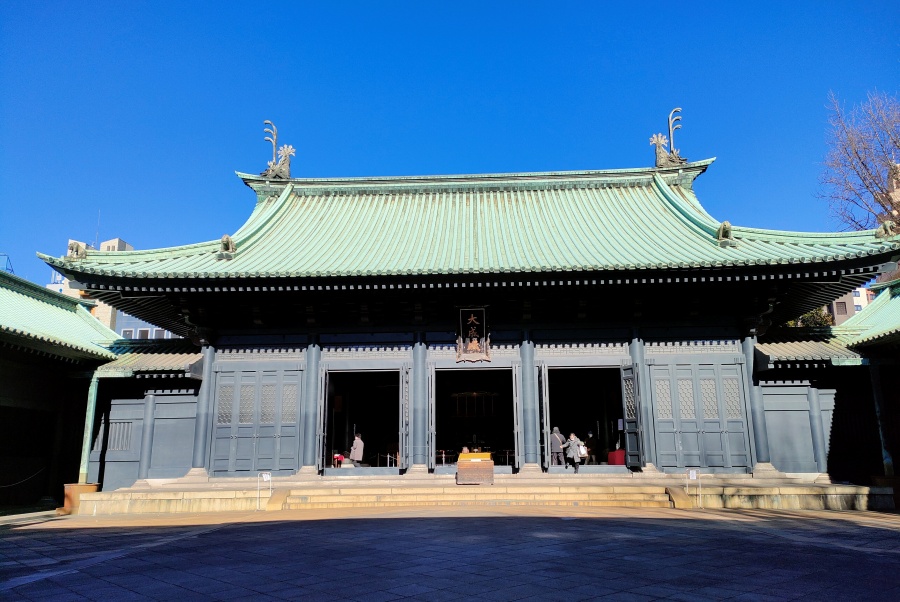
One of the most important temples in Tokyo is the Yushima Sedo Temple. It is a Confucian temple that brings Chinese influence to Japanese culture.
The temples in this area have been renovated and are surrounded by beautiful gardens. A statue of Confucius can also be found in the courtyard.
See the various gates and buildings at this temple, which includes statues of animals on the roofs.
The biggest statue of Confucius in the world is located in the Yushima Seido. It is a prominent part of the temple and has a significant impact on Japanese history.
The Yushima Sedo Temple has a unique black exterior. It has a stately and impressive main building, and it is located in a prominent location.
The entrance to the treasure room is located in the temple’s center. There are various paintings, statues, and artifacts in this room.
The statues of Confucius are surrounded by four wise men. Although these are unique to Japanese style, they lack explanation.
The grounds surrounding the temple are also more beautiful than the building. These include old kai trees that have been planted in honor of Confucius.
The pathway leading to the statue of Confucius has been named after the Lions Club of Taiwan, which donated the statue in 1975.
The structure’s origins can be traced back to the Edo era, when it was erected in what is now known as Ueno Park. It was a school that was studying the teachings of Hayashi Razan.
The building was constructed in 1690 by Tsunayoshi. The tablets containing multiple characters were written in the Shogun’s handwriting. Unfortunately, it has been destroyed by fire three times.
The cornerstone of the building was laid in 1932. During its early years, the school continued to grow, eventually becoming known as Ochanomizu University.
Yushima Seido Temple is located 4 minutes away from the Hijiribashi Exit of the Ochanomizu Station.
English street signs can be found all around the area.
Here’s what Natalia Kostrikova thought about their trip to this place: “Beautiful, very interesting place. This place has a rich, fascinating history . Amazing views. Very nice, deeply personal. There you can have a great rest, learn a lot of interesting things. And also, enjoy relationships. There are lot of amazingly beautiful trees and flowers to see. Recommended.”
Another guest, Milan Juhas, has this to share about their most recent trip here: “Confucian temple that is not too busy, as most tourists are across the street visiting Kanda Shrine. The temple looks nice from outside, but there is not much else to see than the exterior. Inside is a small room with artifact, be aware that there is an entrance fee for this room specifically. It’s possible to see the gardens surrounding temple as well. There you can find a statue of Confucius.”
Meanwhile, Cuong Tran, a satisfied guest, shared their most recent visit to this spot: “This shrine is called Yushima Seido which is the shrine of confucius. In front of this shrine there is a road called Hongo street which was amazingly beautiful during autumn with 2 lines of ginkgo trees. The road lies between Yushima Seido and Tokyo Medical and Dental University. In a cool morning you can enjoy a peaceful walking along this street which definitely turns your mood on for a hard-working day.”
Address: 1-4-25 Yushima, Bunkyo City, Tokyo 113-0034, Japan
Website: http://www.seido.or.jp/
Opening Times: 9:30 am – 5 pm (daily)
Price: Free
Google Map Location:
Zojoji Temple
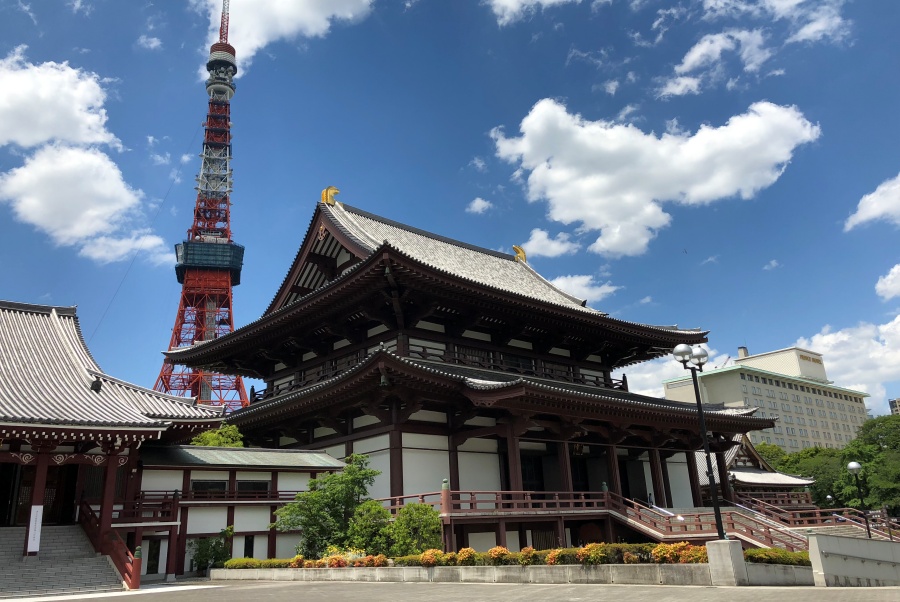
Zojoji Temple is the main temple of the Jodo sect in the Kanto Region. It is located next to Tokyo Tower.
Most of the Zojoji’s structures are currently under reconstruction, except for the main entrance gate, which has survived multiple earthquakes and fires.
The temple was originally built in 1393 and moved to its current location in 1598 by Tokugo Ieyasu. The mausoleum of the family includes the tombs of six Tokugawa shogun.
The museum located in the basement of the main hall focuses on the Tokugawa Mausoleum’s ornate structures before they were destroyed during the Second World War.
The museum features a video about the construction of the temple and a 1:10 scale model of the former structures.
The Zojoji Temple is a Buddhist shrine located in Tokyo. It is right next to the Tokyo Tower. One of its most prominent structures is the Sangedatsumon Gate.
Aside from the Big Bell, visitors can also see the various rooms in the temple, including the Koshoden lecture hall and the Tokugawa Shoguns’ storehouse.
The Zojoji Temple is one of the biggest Buddhist temples in Tokyo. It was first constructed in 1393.
The Zojoji Temple is known for its rich history, and it features the works of noted Japanese artist Kano Kazunobu.
Every year, the Zojoji Temple holds a New Year’s visit known as Hatsumode. During this period, thousands of people visit the temple to pray for peace and health.
Aside from offering prayers, there are also rituals conducted here that involve the burning of relics such as old paper and fabric charms.
During this period, visitors can enjoy various food stands and take advantage of the hot sweet rice wine offered at these stores.
One of the most popular attractions of the temple is the Jizo statues, which are made of bronze. These statues represent the unborn children of Japan.
Most of the time, the statues are seen wearing children’s clothes. They also receive offerings from the people praying for the protection of the children.
The Zojoji Temple is easily accessible from the subway lines. The nearest stations are the Shibakoen Station and the Onarimon Station.
The temple is open from 9 am to 5 pm every day. After visiting the site, people can drop by the Tokyo Tower to get in touch with the locals.
Take a photo of the temple with the Tokyo Tower in the background to capture the contrast between the traditional and modern sides of Tokyo.
Here’s what Aditya Harin Nugroho thought about their trip to this place: “A very large buddha temple and the area is very wide. There are many beautiful parks around it. The scenery is very beautiful especially with the Tokyo Tower, this temple becomes even more beautiful.
In autumn many trees turn red. So pretty. The very large gate that is on the side of the main road is also very interesting.”
Another guest, Aditri Biswas, has this to share about their last trip here: “It is a beautiful shrine located near the Tokyo tower. Peaceful and quiet, you can’t believe it is in the middle of a city. We were able to view the Evening service as well which started around 5 pm.
Just beside it is the Tokyo tower. During the evening, when the tower is lit, it looks beautiful and quite majestic. There are many coffee shops around in this area if you want a quick break.”
Meanwhile, Prapulla Ba, satisfied guest, shared some of her fondest memories the last time she went here to visit: “Most beautiful temple to visit in Tokyo. I am really mesmerized by the calmness and peacefulness of the temple. The statue of Buddha enhances the positive vibes. Just stand in front of the Buddha and forget the whole world. The place is really spiritual and devotional. It’s near to the Tokyo tower ?located in Shiba. Easily accessible from various places via metro. The first sight of the temple with the beautiful Tokyo tower ? behind it delight to eyes. Zozoji temple has a great history in Tokyo. The main gate was built in 1622. It has witnessed various earthquakes and wars. There is also a memorial of the priests and mothers near to it. Don’t miss the autumn ? valley park near to the zozoji temple.”
Deb, who was able to see this place pre-pandemic, shared her most memorable moments visiting here: “Beautiful temple with many buildings, shrines, statues and history etc. Has a gorgeous tea house set in lovely setting and you can book for tea ceremony (but I think they only have them once a month). Lovely to spend time in the grounds here and visit the temple. The area for the guardians of the children was beautiful and quite an emotional experience.”
Here’s what Rene Trevino thought about their visit here: “A wonderful temple complex with many statues, monuments and temples. It is very close to the Tokyo Tower so it’s advantageous to visit before or after the tower. The temple allows for peaceful and quiet contemplation throughout the area. The child monuments are beautiful with their colorful hats and bibs. It has a lot of history in a central location.”
Address: 4 Chome-7-35 Shibakoen, Minato City, Tokyo 105-0011, Japan
Website: https://www.zojoji.or.jp/en/
Opening Times: 9 am – 5 pm (daily)
Price: Free
Google Map Location:
Shrine And Temple Etiquette in Japan
Many of Japan’s most popular tourist attractions are temples and shrines, but there are also lesser-known gems all around the country.
Since ancient times, Japanese people have been visiting these sacred places to pray for a good year.
While many Japanese people are not familiar with the etiquette of visiting a shrine or temple, this guide will teach them how to do their own things right.
On the day of their visit, people are called omairi for the act of praying at a shrine. This practice is done for the new year, and it is referred to as hatsu-moude.
Some people worry that visiting too many temples and shrines will bring bad luck, since these are all divine. However, this myth is not true, as each of these temples and shrines has its own divine virtues.
Although many people are aware of the difference between a shrine and a temple, many are not aware of the proper way to pray at these places.
There are two easy ways to tell the difference between a temple and a shrine. First, the gate at a temple is usually a large house, while the entrance to a shrine is usually a small gate.
To sum up the differences between the two, the gods and Buddhas reside in different places.
Visiting A Shrine in Japan
Before entering the torii gates, bow slightly to the side of the path so that it can be viewed from the center.
Upon reaching the shrine, there is a small basin filled with water. Before entering the main shrine, make sure to clean both of your hands by pouring some water on one hand and leaving the other hand to clean.
The ladle should be placed vertically, allowing the water to trickle down.
Once you’re at the shrine, there are various steps you can do to proceed. Some of these include paying respects and entering the torii gates.
- Bow slightly
- Toss a penny into the box in front of you gently. The quantity of money doesn’t matter; just because you used a 500 yen coin doesn’t imply your desires are more likely to come true. Because go-en is homophonous to the Japanese word for “relationship,” many Japanese people think that using a 5-yen coin boosts their chances of meeting a significant other. However, this is really an urban legend; gods existed before the yen currency.
- Ring the bell (if there is one) two or three times to let the gods know you’ve arrived.
- Twice, bow deeply (until you reach a 90-degree angle).
- Clap twice, slightly in front of your left hand.
Visiting A Temple in Japan
When visiting a certain site, the rules are the same as those of visiting a shrine. However, the way in which you pay respect varies.
- Burn incense (which is generally available at the temple); the aroma of incense is nourishment for the Buddha. Lighting your own incense stick from the burning sticks of others is forbidden because it implies taking on their sins.
- Bow slightly
- Toss a penny into the box in front of you gently.
- 2 or 3 times, ring the bell (if there is one).
- Bow gently and pay your respects, bringing your hands together but DO NOT CLAP, and pray while holding a string of beads or a rosary. Remember to thank the Buddha!
- Bow slightly
What to Do Next
You can also buy ema at shrines. These are small wooden plaques that are placed on top of a pile of flowers and are meant to be received by the gods!
Hamaya are holy arrows that people use to ward off evil spirits. There are various kinds of omamori, or amulets, and they’re commonly used for road safety.
Aside from ema, there are also omikuji, which are slips of paper that contain fortunes that are written on them. These are usually only sold for a hundred yen.
Some omikuji shrines also offer English translations. The following are the kinds of omikuji fortunes that are regarded as best or worst:
- dai-kichi (大吉) – great blessing
- chuu-kichi (中吉) – middle blessing
- sho-kichi (小吉) – small blessing
- kichi (吉) – blessing
- sue-kichi (末吉) – ending blessing
- kyo (凶) – curse
- dai-kyo (大凶) – great curse
Omikuji can provide advice on various aspects of the upcoming year, including travel, relationships, and health.
Follow these simple steps to experience a truly Japanese experience when visiting a Japanese shrine or temple.
FINAL THOUGHTS
When you’re in Japan, one of the things that you shouldn’t miss out doing is visiting a shrine or a temple – maybe even if not for religious purposes, but for the culture and experience of seeing one in person, it’s going to be worthwhile. And mind you, depending on the time of the year, hundreds if not thousands of tourists visit shrines in Japan. This can be easily any locals’ holiday activity or time-off from work or daily life. This is because Japan has lots of great places to visit with awesome sceneries and stuff you can do. The only thing you should concern yourself first is the time and means to get around these places because there are thousands of them – they’re literally EVERYWHERE. And with that, happy shrine/temple hunting and may the year be auspicious to you and your whole family – even amid these challenging times.
Have you been to any shrines and temples from where you’re from? When you visit Japan, which temples/shrines would you like to visit first? Let us know by leaving a comment in the section below!
READ NEXT: Top 10 Tourist Spots in Japan
